Abstract
The hypothesis has been put forward that humans and wildlife species adverse suffered adverse health effects after exposure to endocrine-disrupting chemicals. Reported adverse effects include declines in populations, increases in cancers, and reduced reproductive function. The U.S. Environmental Protection Agency sponsored a workshop in April 1995 to bring together interested parties in an effort to identify research gaps related to this hypothesis and to establish priorities for future research activities. Approximately 90 invited participants were organized into work groups developed around the principal reported health effects-carcinogenesis, reproductive toxicity, neurotoxicity, and immunotoxicity-as well as along the risk assessment paradigm-hazard identification, dose-response assessment, exposure assessment, and risk characterization. Attention focused on both ecological and human health effects. In general, group felt that the hypothesis warranted a concerted research effort to evaluate its validity and that research should focus primarily on effects on development of reproductive capability, on improved exposure assessment, and on the effects of mixtures. This report summarizes the discussions of the work groups and details the recommendations for additional research.
Full text
PDF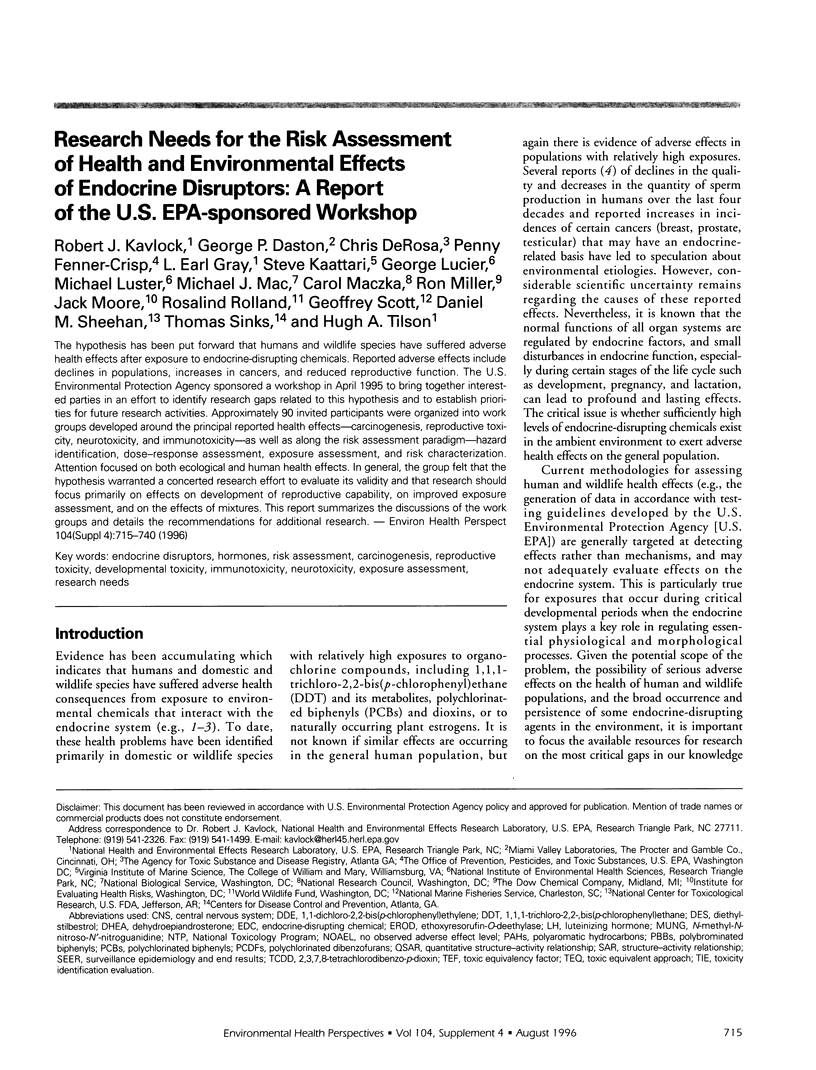
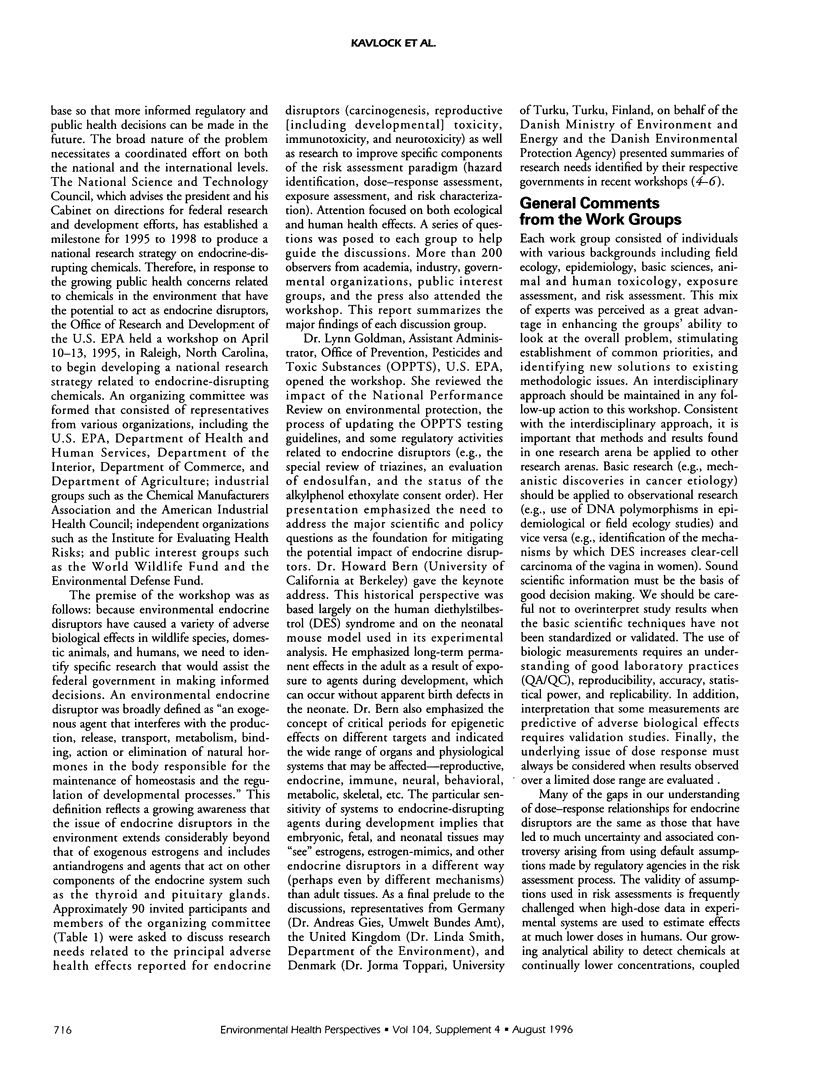
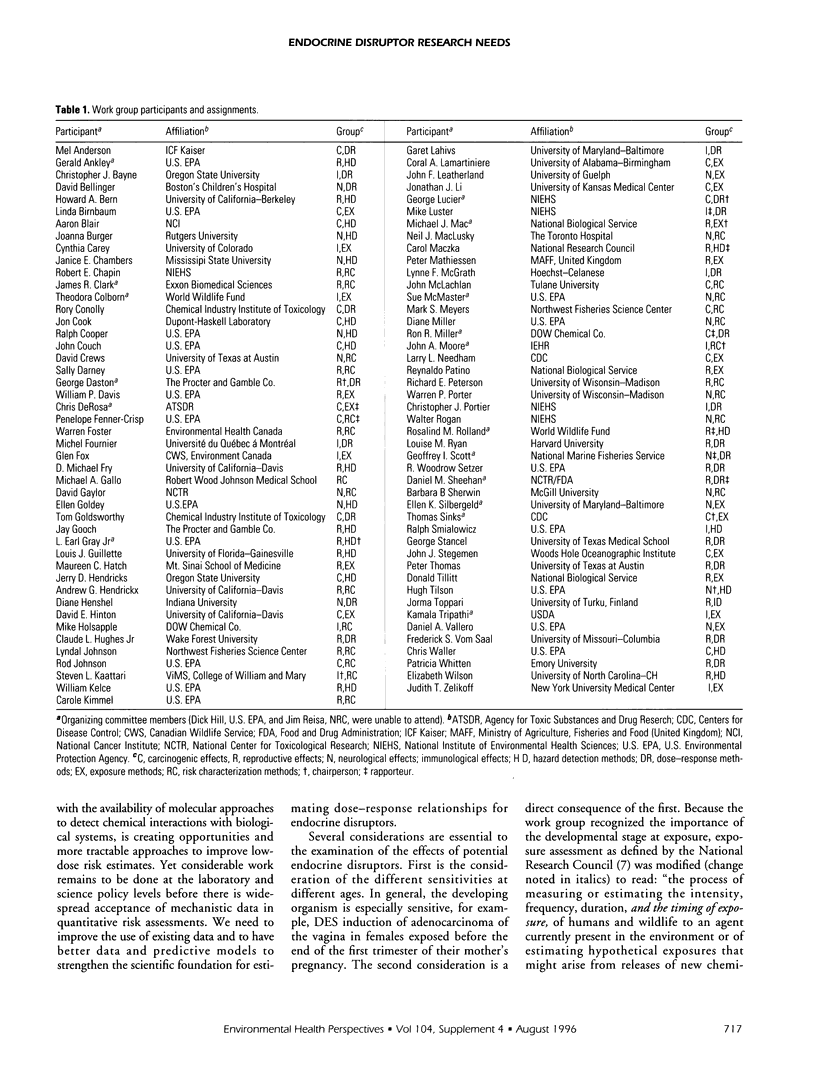
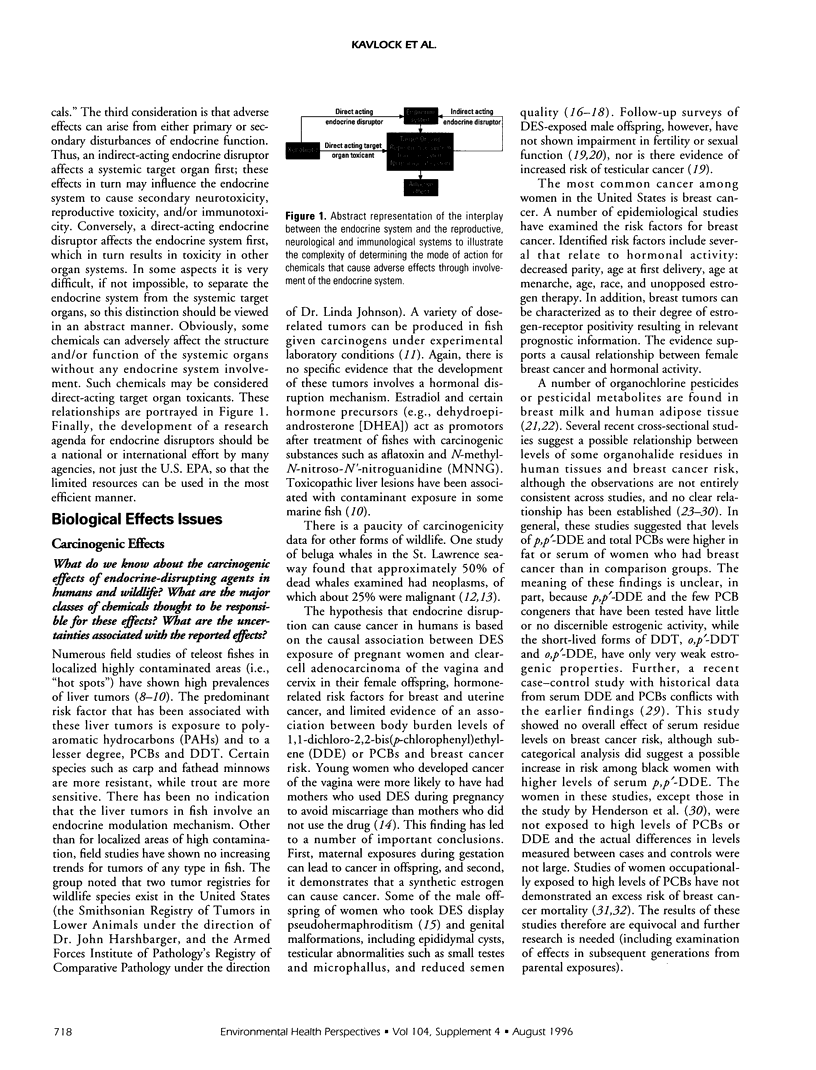
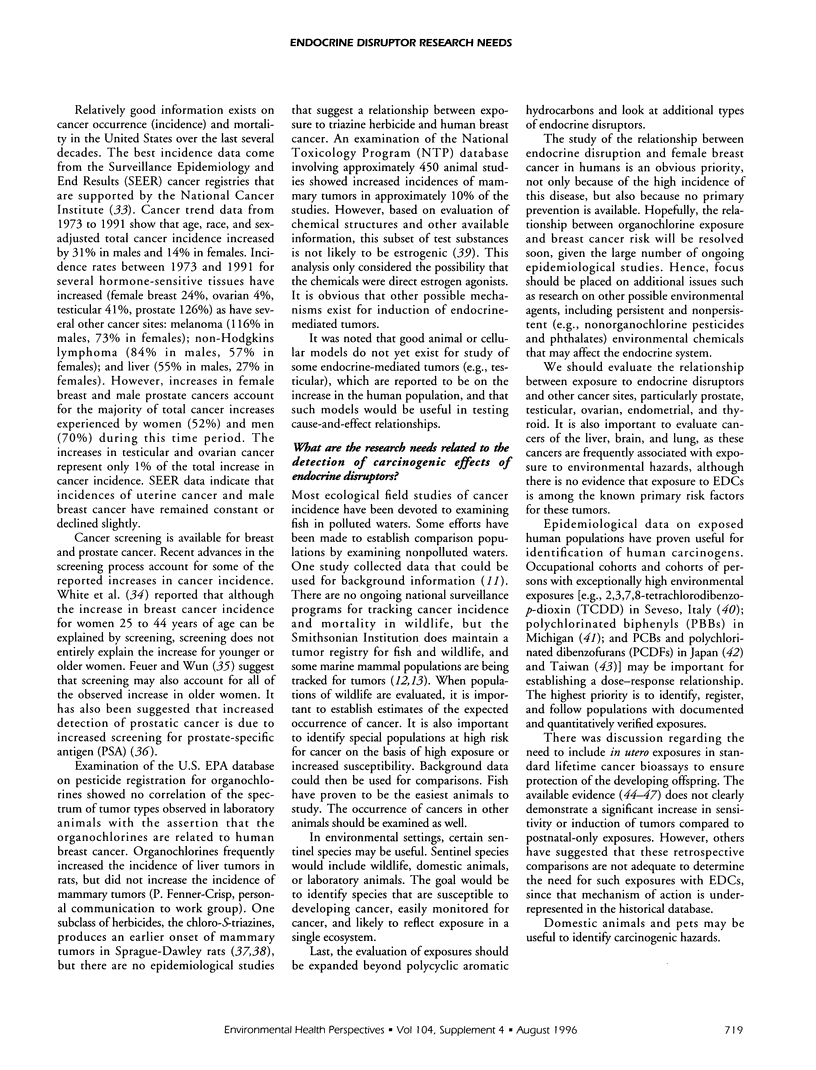
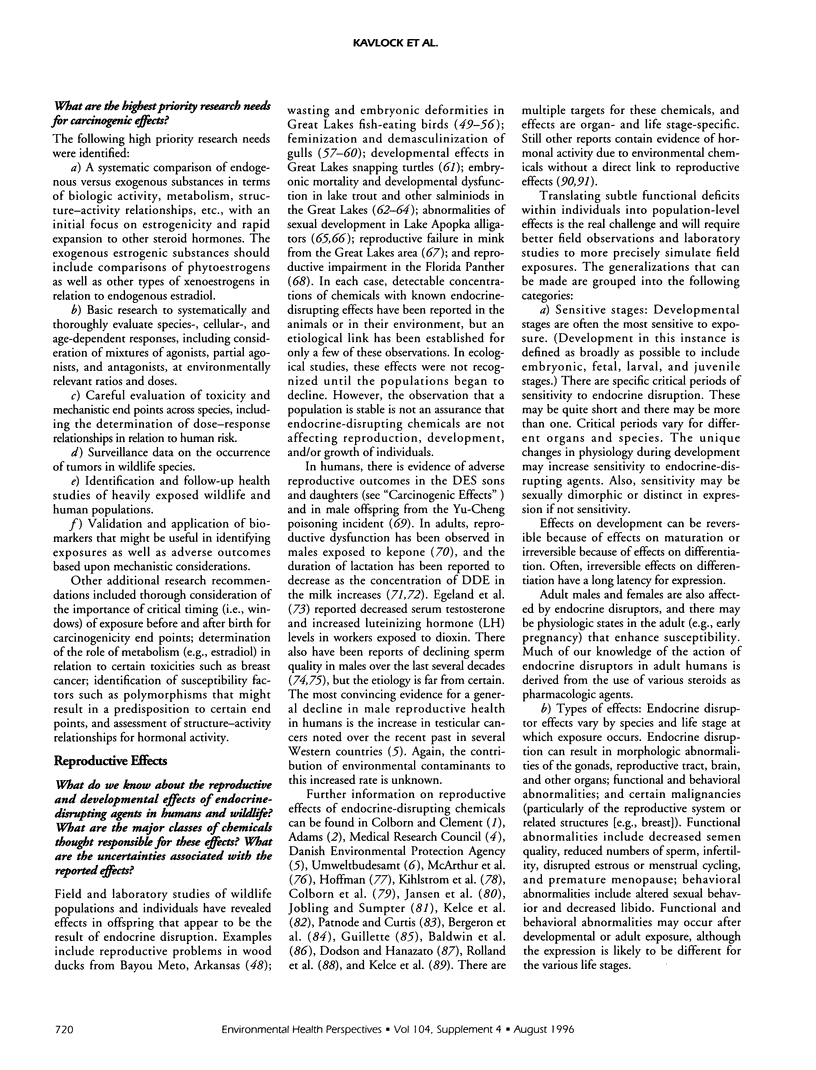
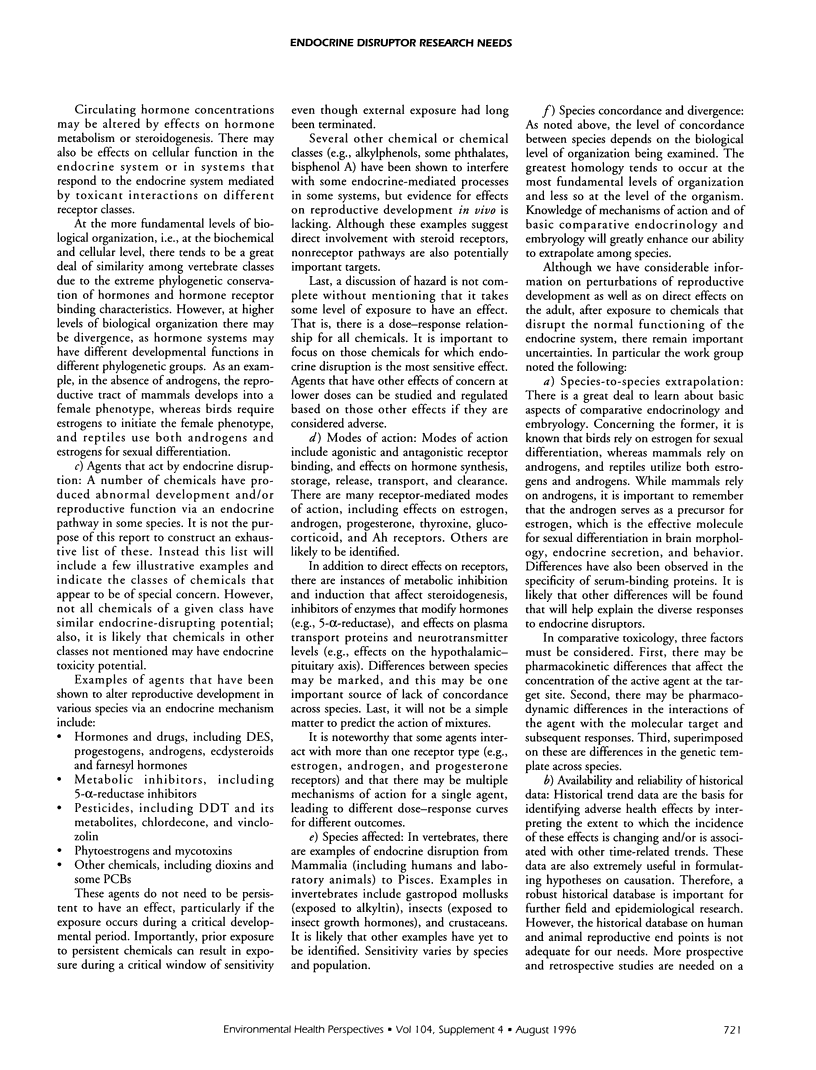
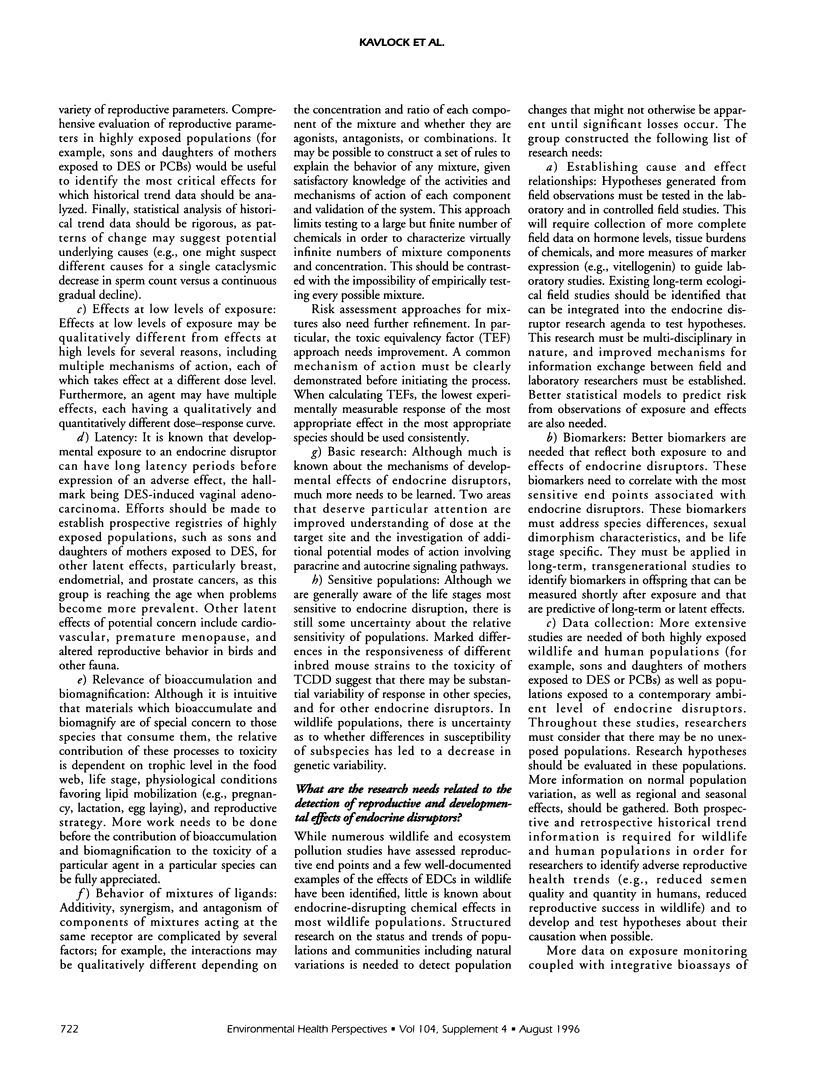
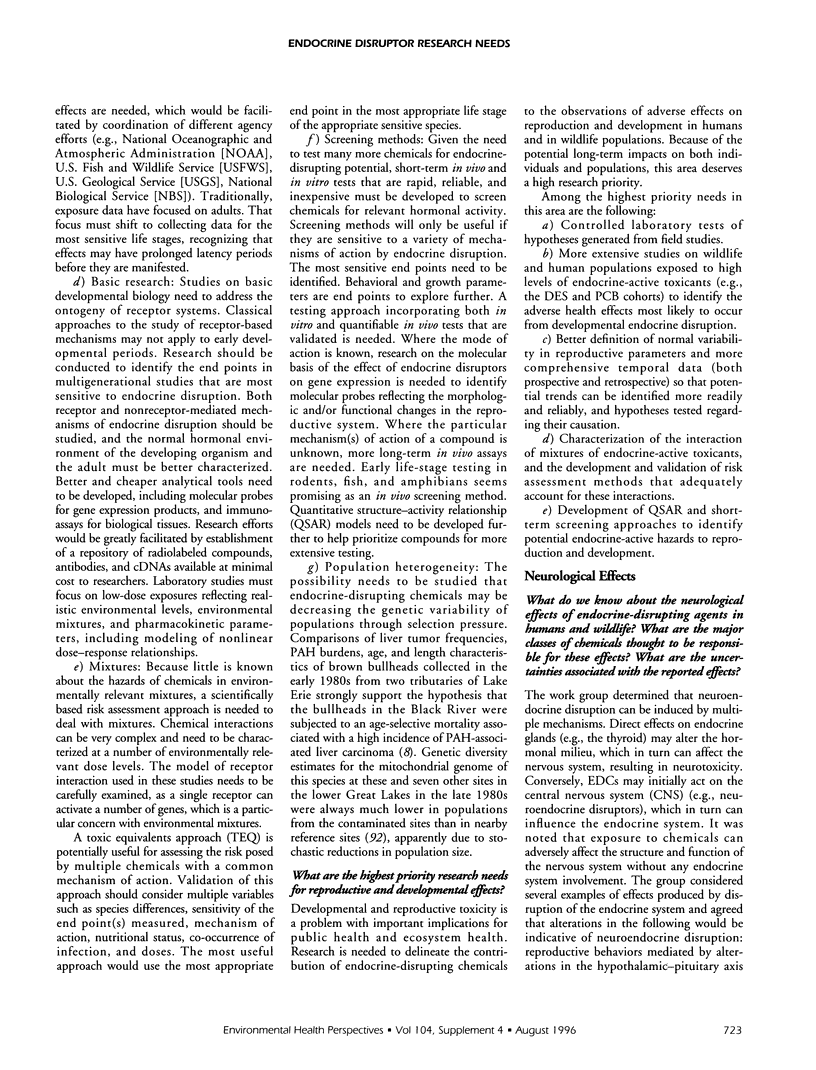
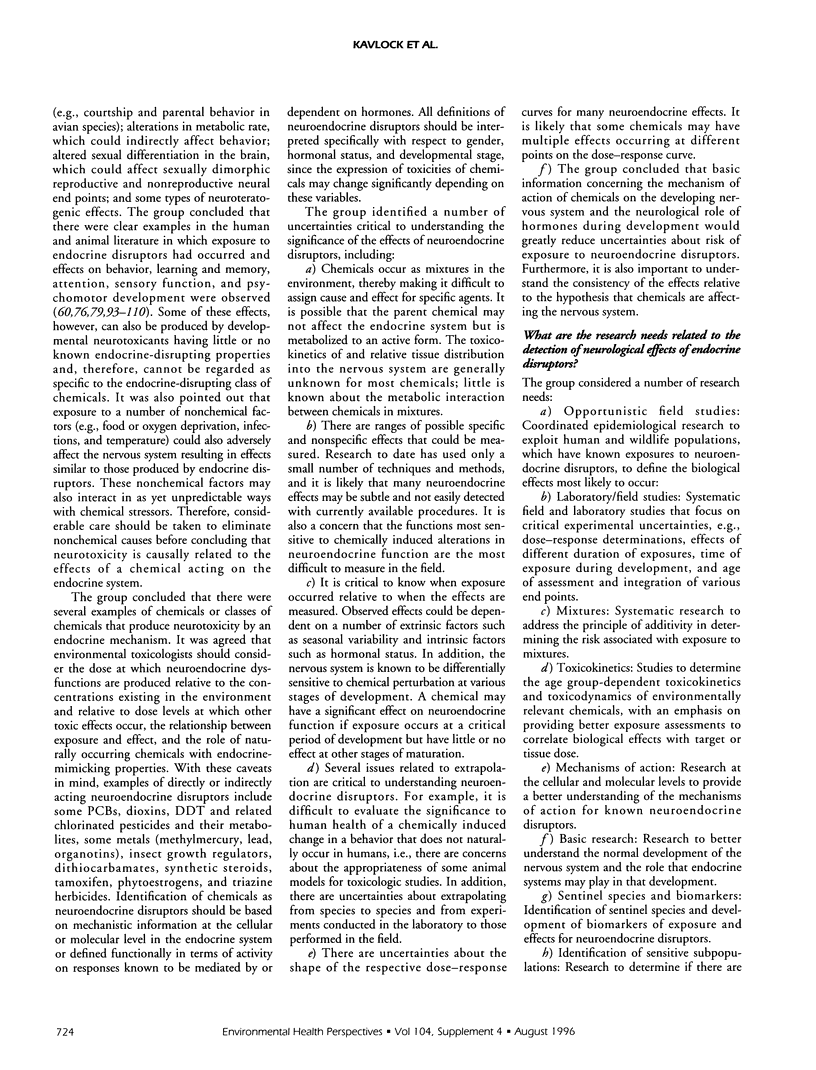
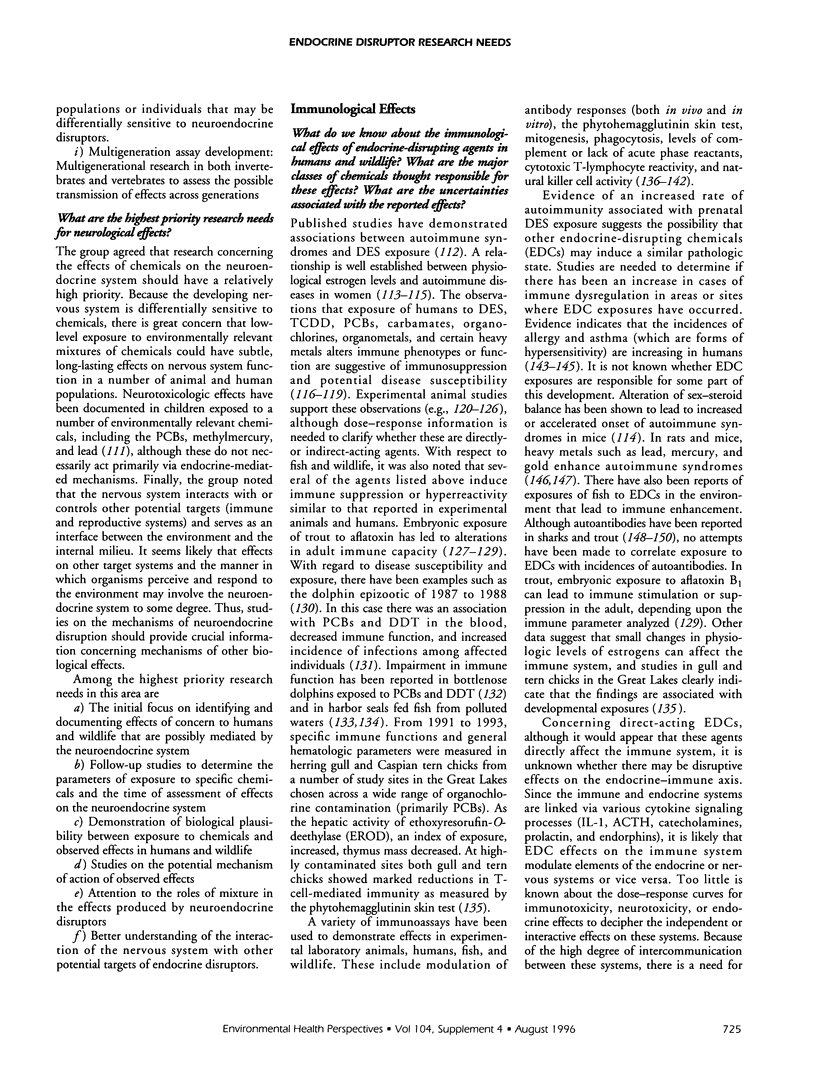
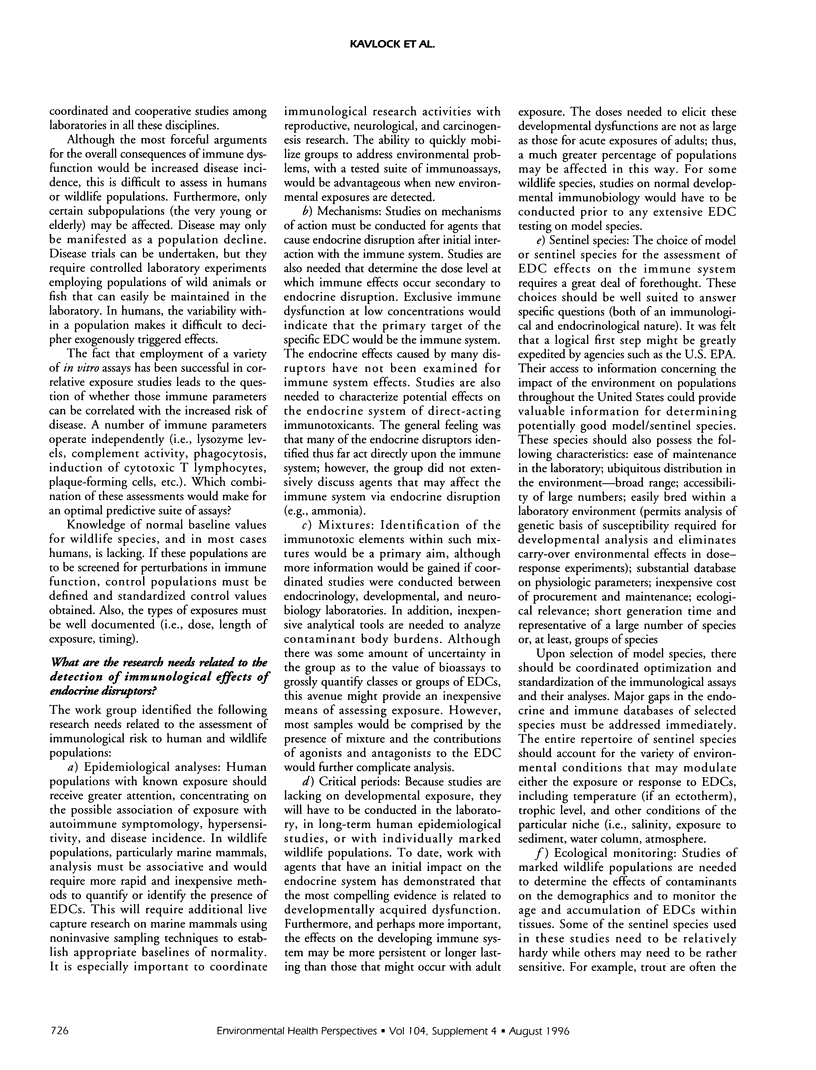
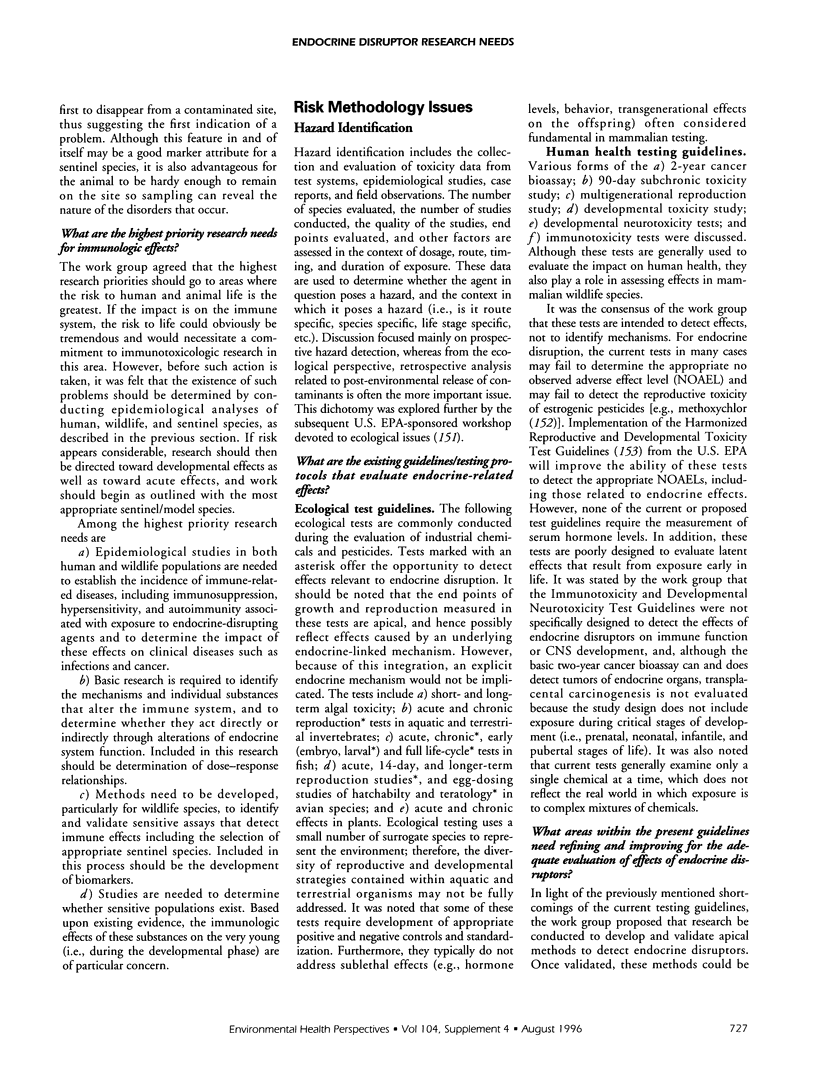
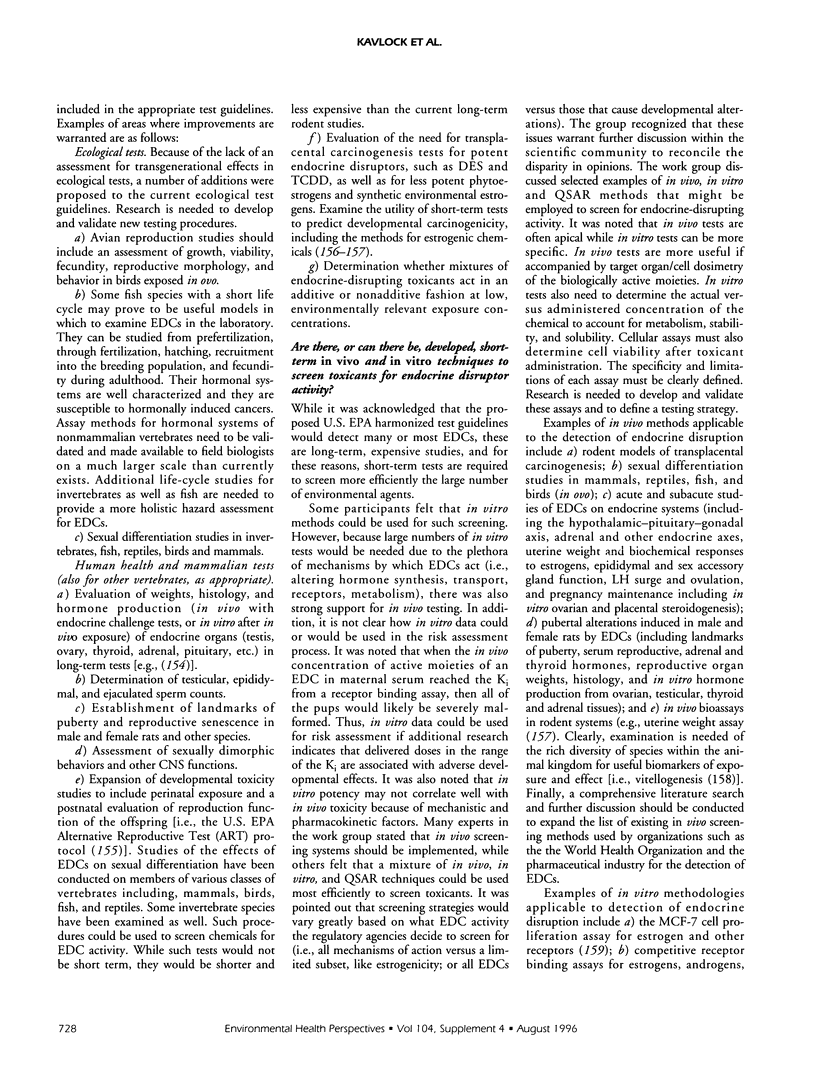
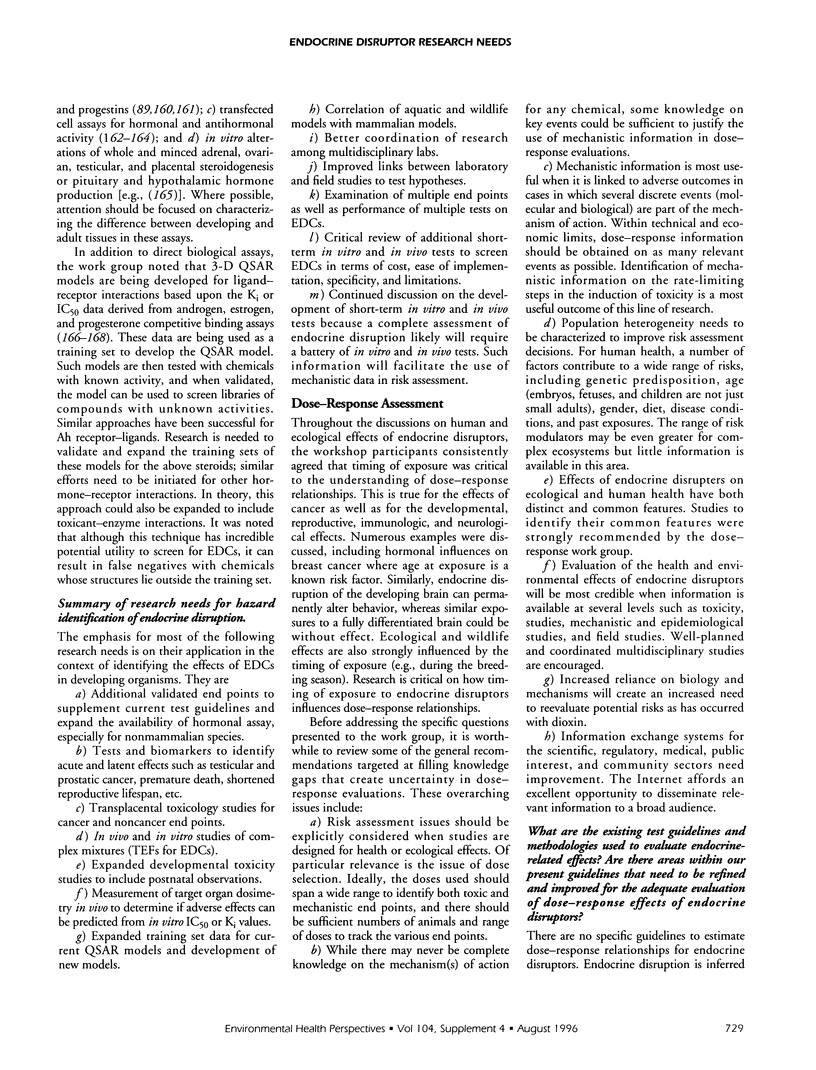
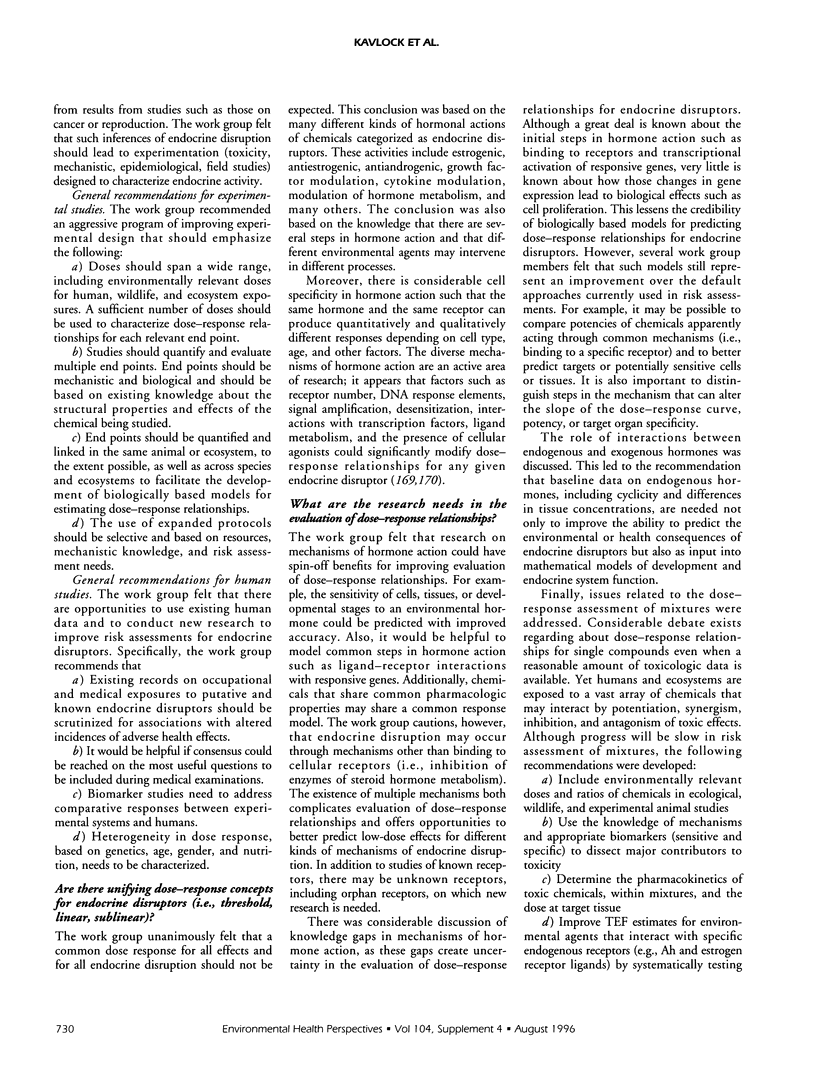
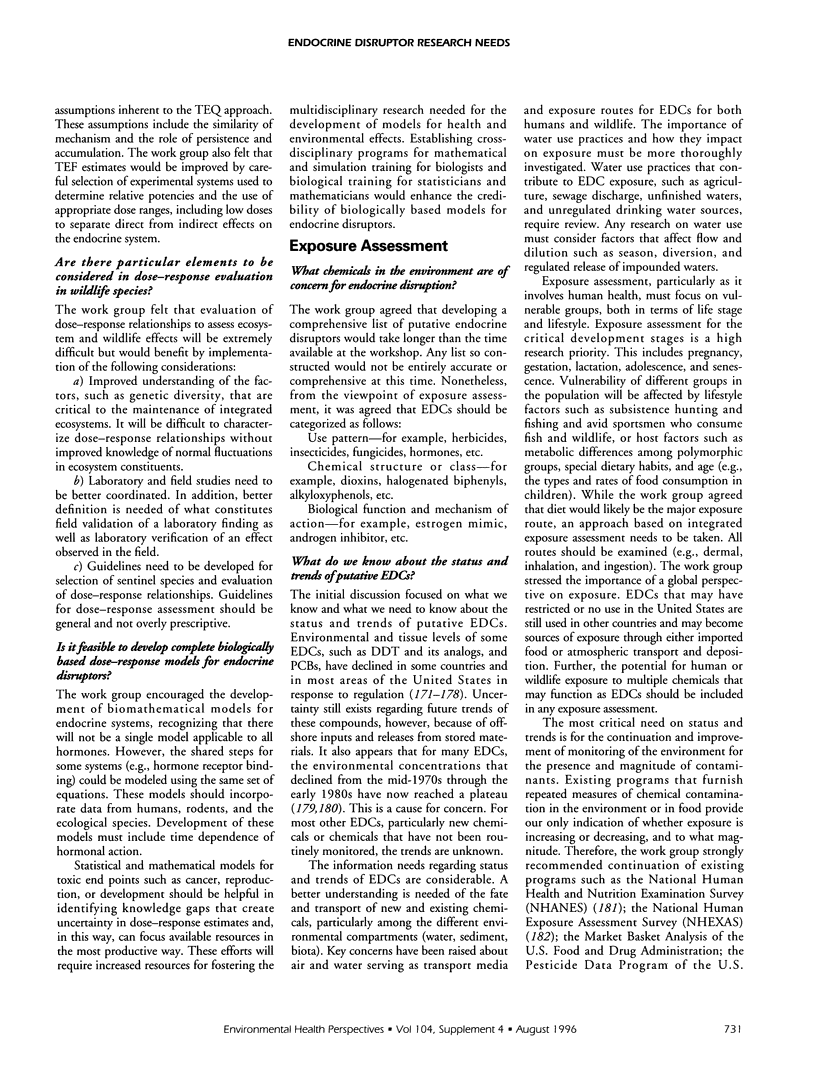
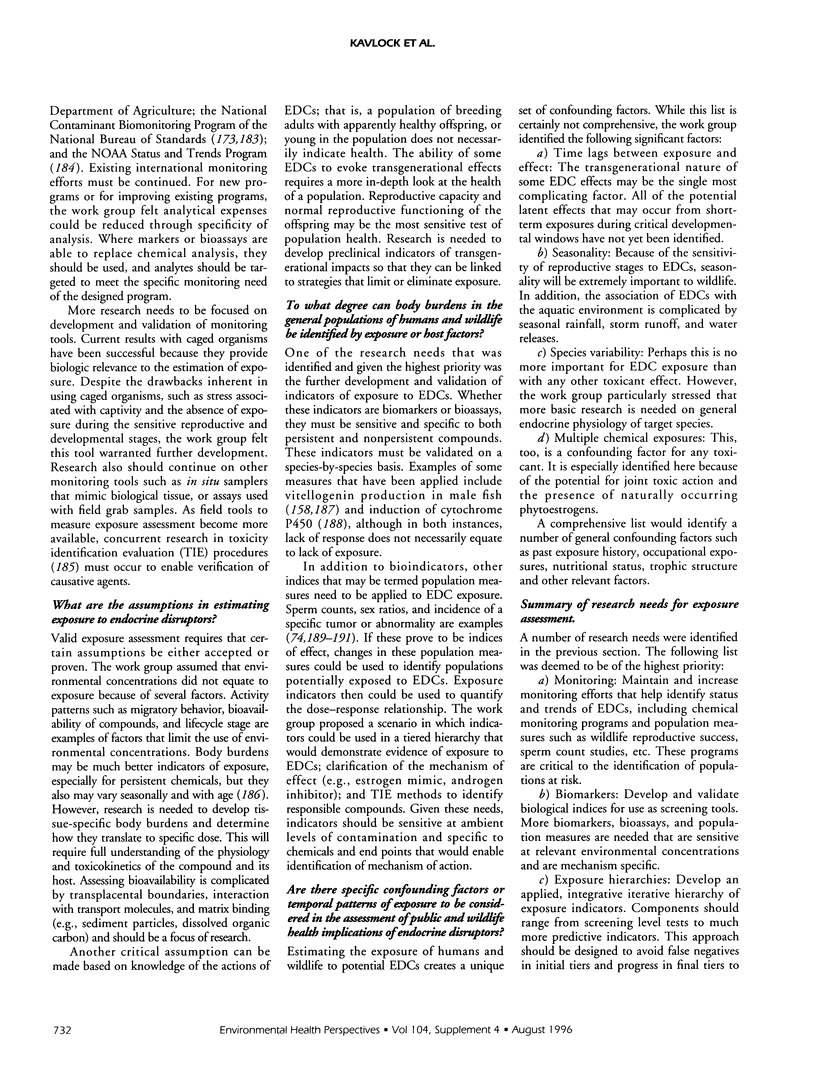
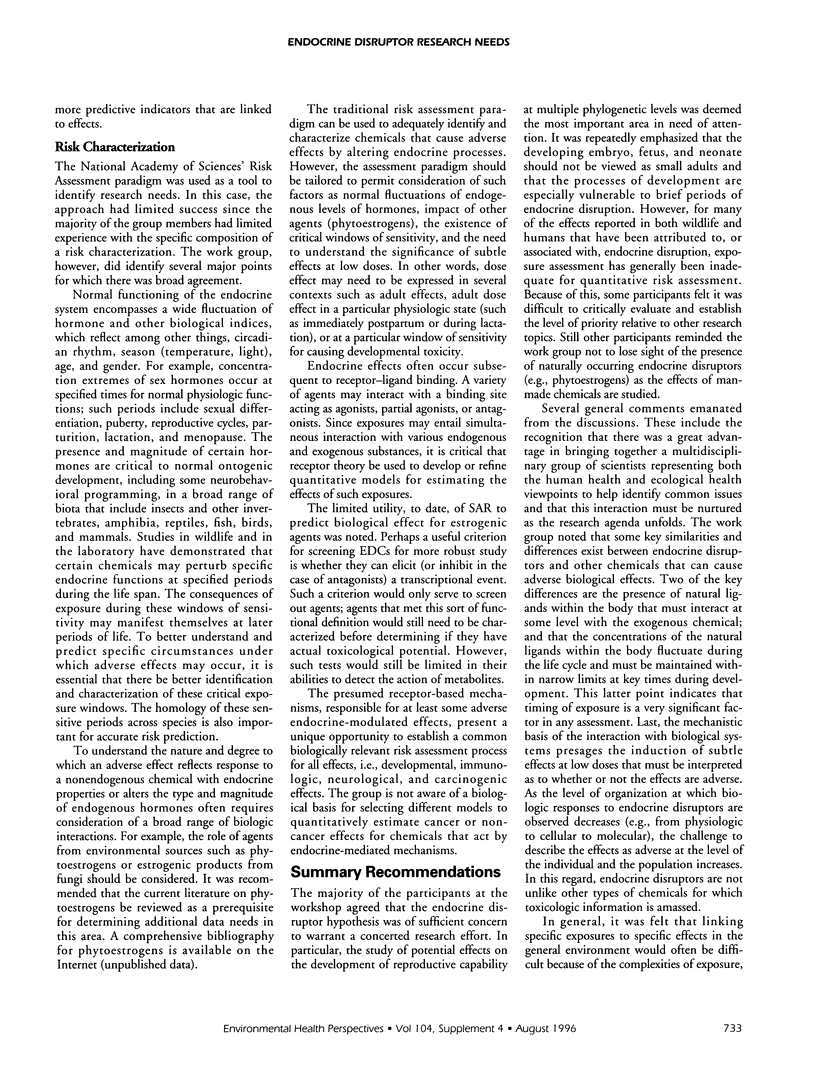
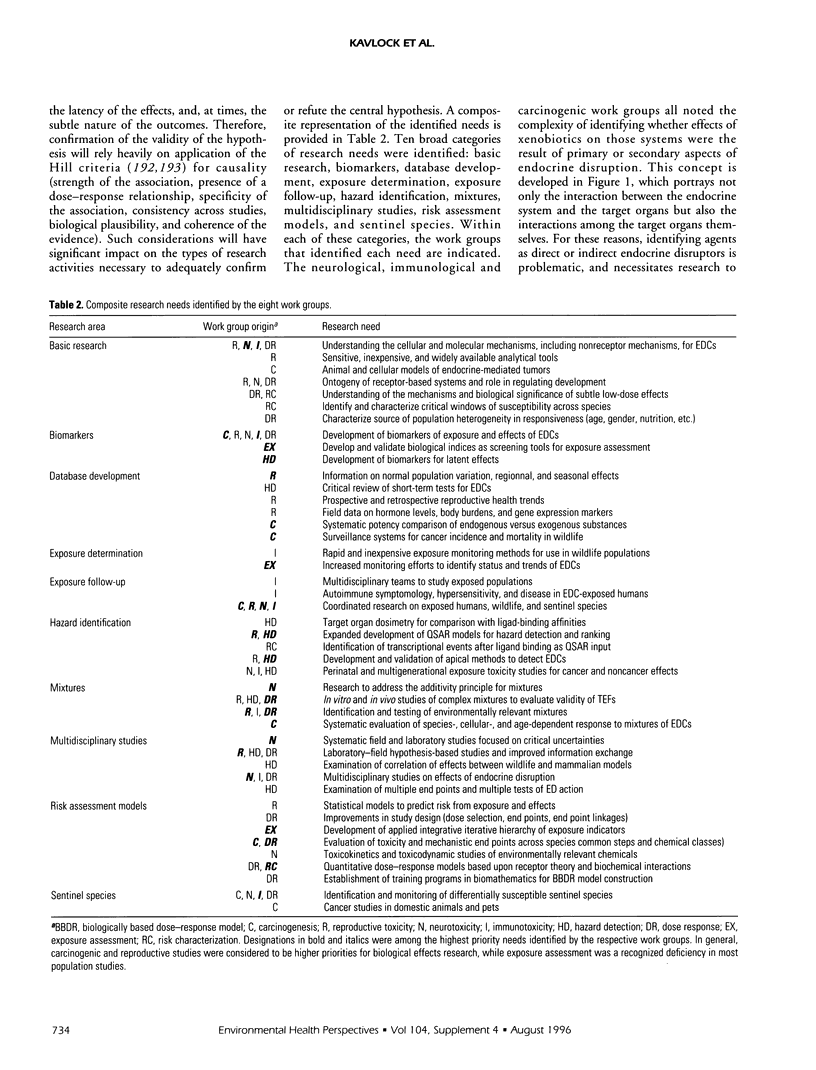
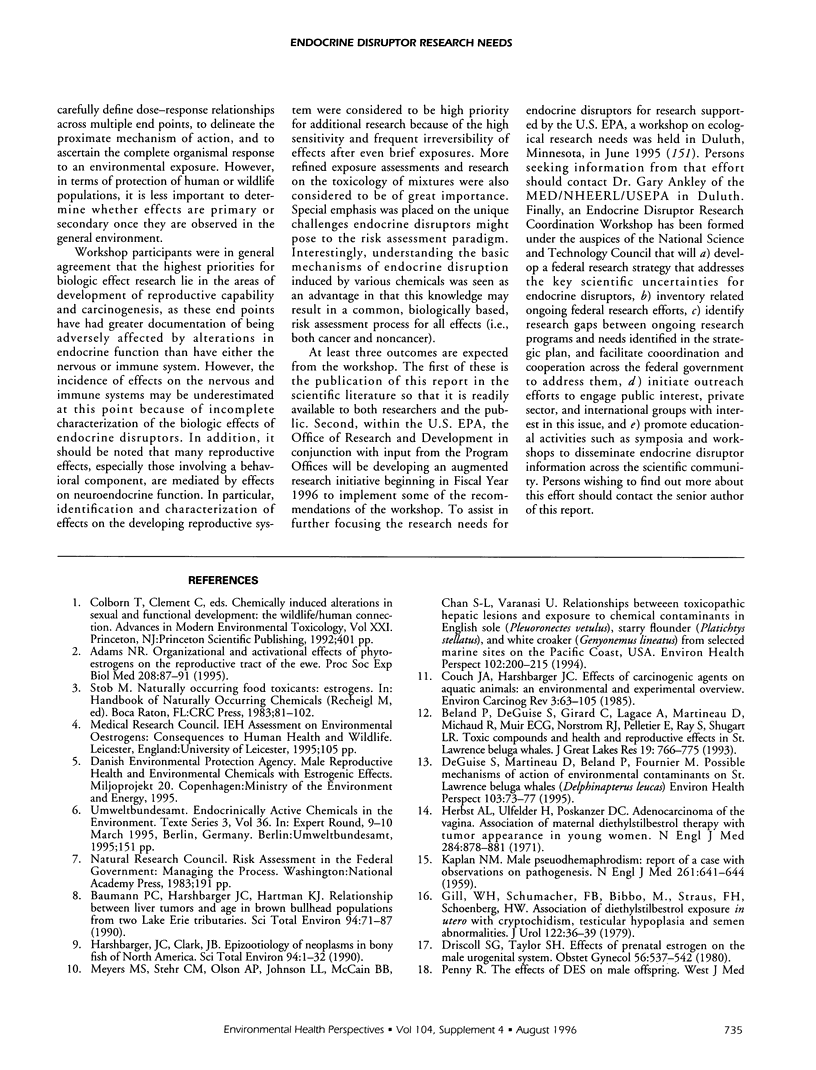
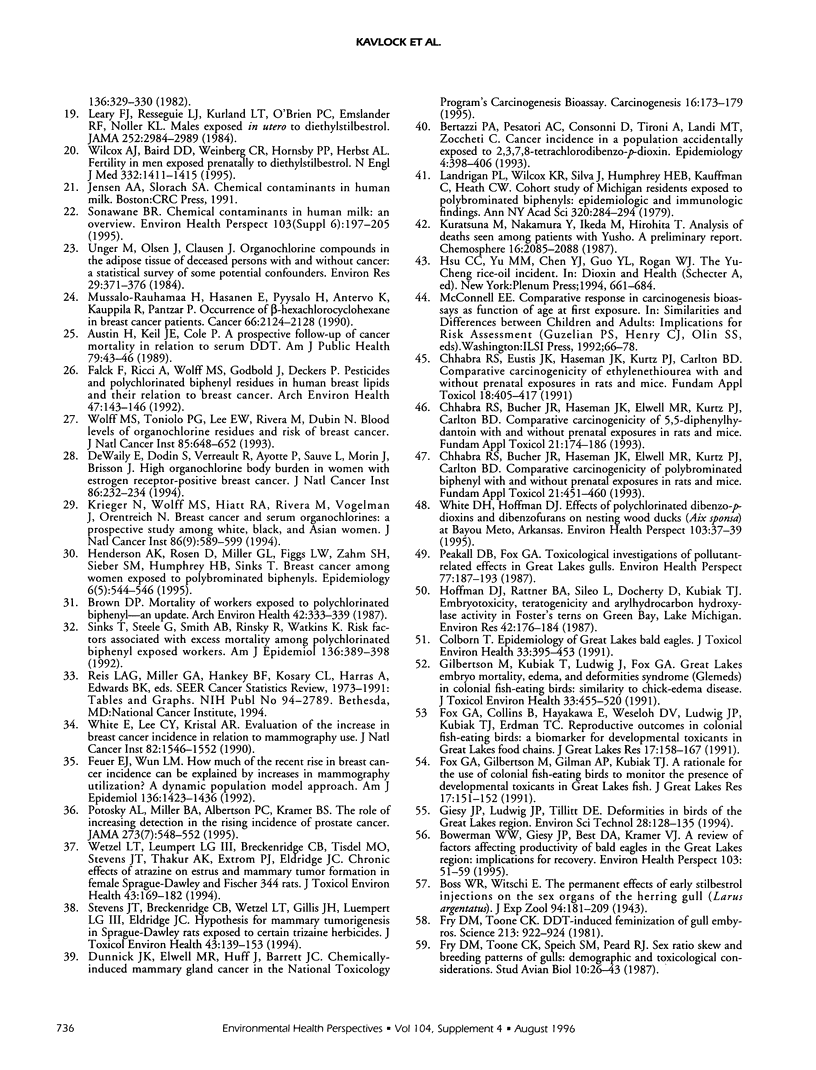
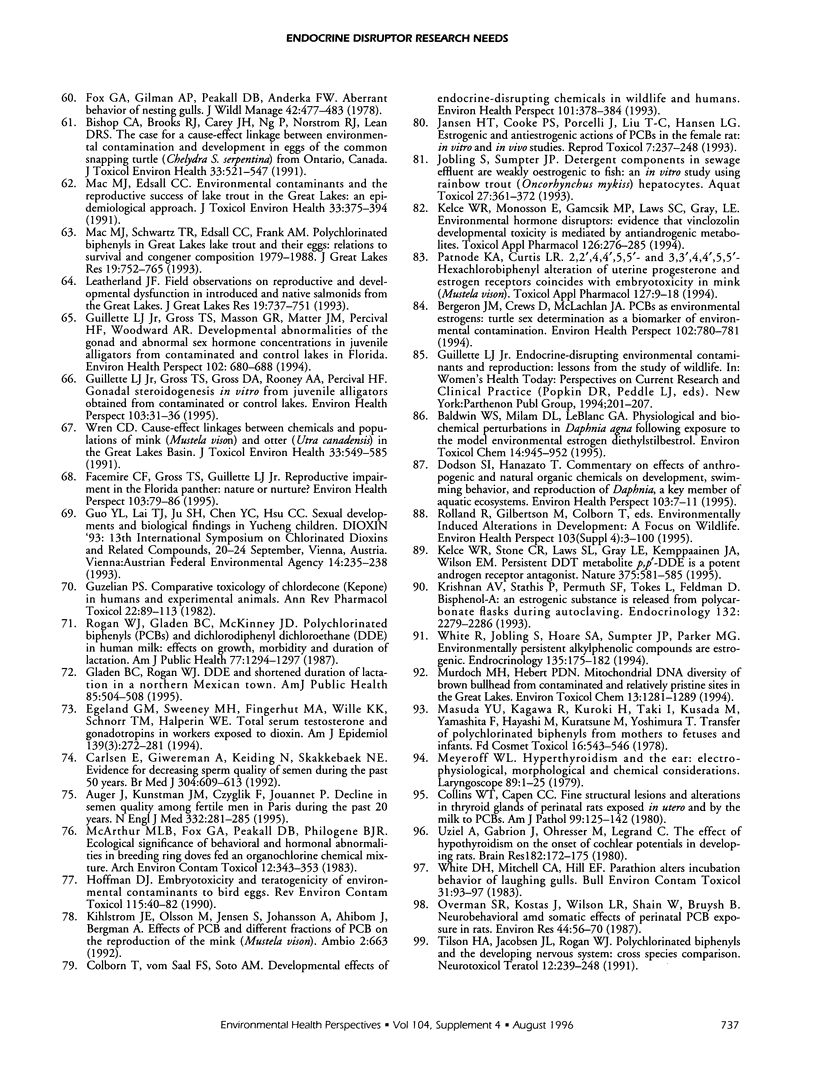
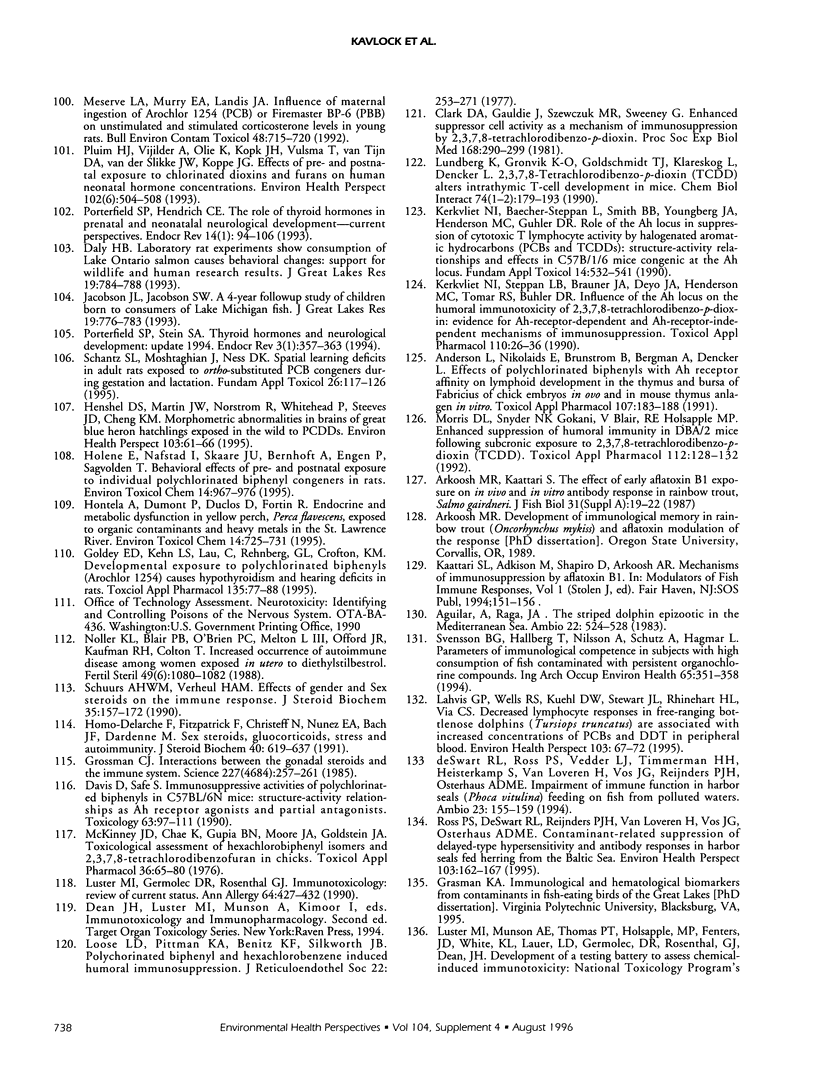
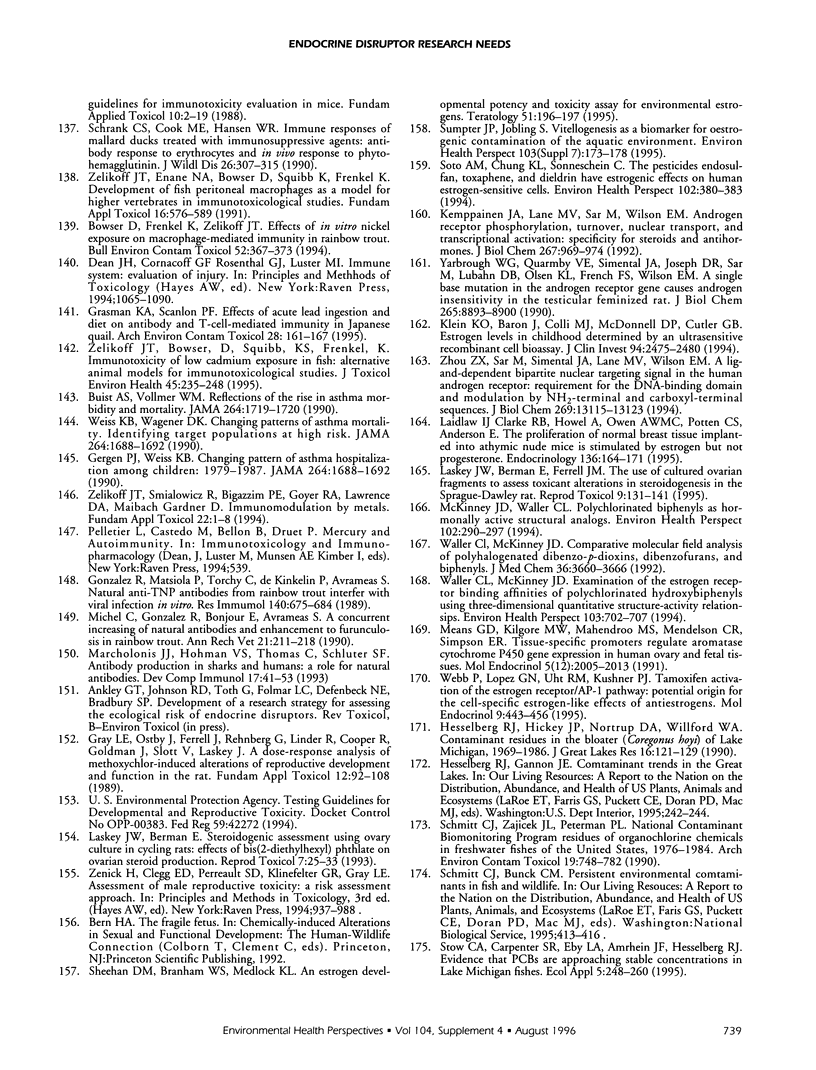
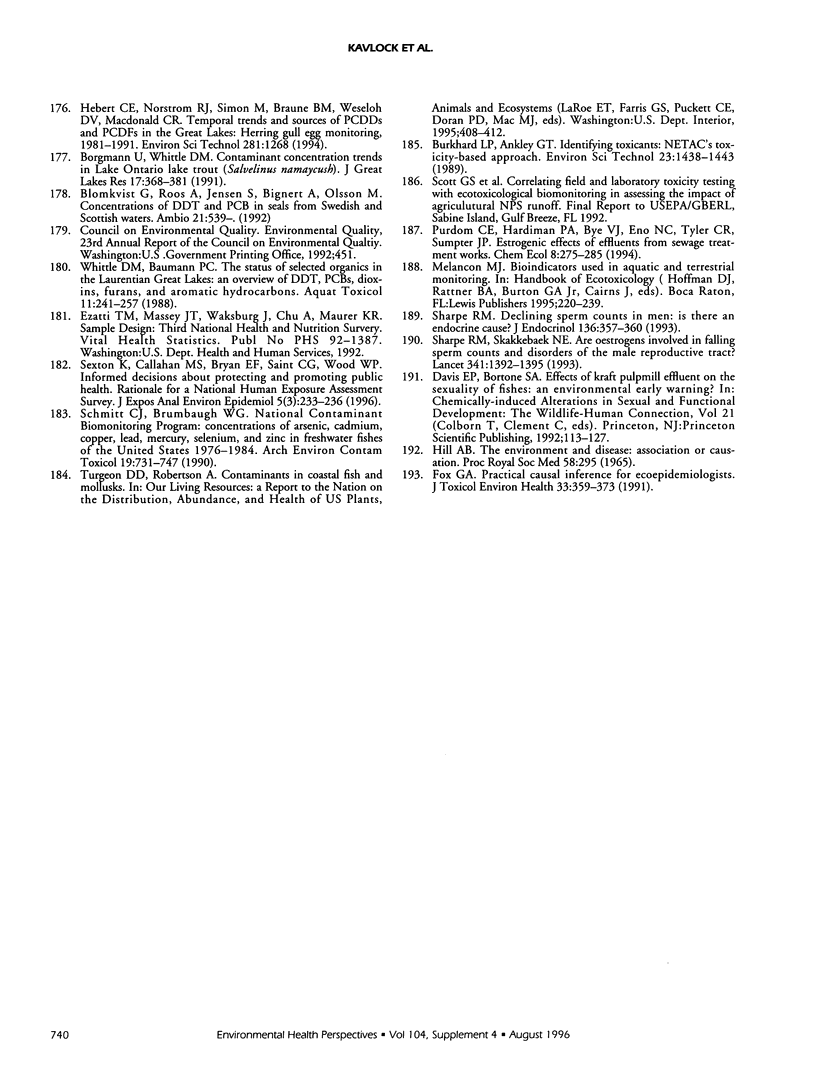
Selected References
These references are in PubMed. This may not be the complete list of references from this article.
- Adams N. R. Organizational and activational effects of phytoestrogens on the reproductive tract of the ewe. Proc Soc Exp Biol Med. 1995 Jan;208(1):87–91. doi: 10.3181/00379727-208-43837. [DOI] [PubMed] [Google Scholar]
- Andersson L., Nikolaidis E., Brunström B., Bergman A., Dencker L. Effects of polychlorinated biphenyls with Ah receptor affinity on lymphoid development in the thymus and the bursa of Fabricius of chick embryos in ovo and in mouse thymus anlagen in vitro. Toxicol Appl Pharmacol. 1991 Jan;107(1):183–188. doi: 10.1016/0041-008x(91)90342-c. [DOI] [PubMed] [Google Scholar]
- Auger J., Kunstmann J. M., Czyglik F., Jouannet P. Decline in semen quality among fertile men in Paris during the past 20 years. N Engl J Med. 1995 Feb 2;332(5):281–285. doi: 10.1056/NEJM199502023320501. [DOI] [PubMed] [Google Scholar]
- Austin H., Keil J. E., Cole P. A prospective follow-up study of cancer mortality in relation to serum DDT. Am J Public Health. 1989 Jan;79(1):43–46. doi: 10.2105/ajph.79.1.43. [DOI] [PMC free article] [PubMed] [Google Scholar]
- Baumann P. C., Harshbarger J. C., Hartman K. J. Relationship between liver tumors and age in brown bullhead populations from two Lake Erie tributaries. Sci Total Environ. 1990 May 1;94(1-2):71–87. doi: 10.1016/0048-9697(90)90365-2. [DOI] [PubMed] [Google Scholar]
- Bergeron J. M., Crews D., McLachlan J. A. PCBs as environmental estrogens: turtle sex determination as a biomarker of environmental contamination. Environ Health Perspect. 1994 Sep;102(9):780–781. doi: 10.1289/ehp.94102780. [DOI] [PMC free article] [PubMed] [Google Scholar]
- Bertazzi A., Pesatori A. C., Consonni D., Tironi A., Landi M. T., Zocchetti C. Cancer incidence in a population accidentally exposed to 2,3,7,8-tetrachlorodibenzo-para-dioxin. Epidemiology. 1993 Sep;4(5):398–406. doi: 10.1097/00001648-199309000-00004. [DOI] [PubMed] [Google Scholar]
- Bishop C. A., Brooks R. J., Carey J. H., Ng P., Norstrom R. J., Lean D. R. The case for a cause-effect linkage between environmental contamination and development in eggs of the common snapping turtle (Chelydra S.serpentina) from Ontario, Canada. J Toxicol Environ Health. 1991 Aug;33(4):521–547. doi: 10.1080/15287399109531539. [DOI] [PubMed] [Google Scholar]
- Bowerman W. W., Giesy J. P., Best D. A., Kramer V. J. A review of factors affecting productivity of bald eagles in the Great Lakes region: implications for recovery. Environ Health Perspect. 1995 May;103 (Suppl 4):51–59. doi: 10.1289/ehp.95103s451. [DOI] [PMC free article] [PubMed] [Google Scholar]
- Bowser D. H., Frenkel K., Zelikoff J. T. Effects of in vitro nickel exposure on the macrophage-mediated immune functions of rainbow trout (Oncorhynchus mykiss). Bull Environ Contam Toxicol. 1994 Mar;52(3):367–373. doi: 10.1007/BF00197823. [DOI] [PubMed] [Google Scholar]
- Brown D. P. Mortality of workers exposed to polychlorinated biphenyls--an update. Arch Environ Health. 1987 Nov-Dec;42(6):333–339. doi: 10.1080/00039896.1987.9934355. [DOI] [PubMed] [Google Scholar]
- Buist A. S., Vollmer W. M. Reflections on the rise in asthma morbidity and mortality. JAMA. 1990 Oct 3;264(13):1719–1720. [PubMed] [Google Scholar]
- Carlsen E., Giwercman A., Keiding N., Skakkebaek N. E. Evidence for decreasing quality of semen during past 50 years. BMJ. 1992 Sep 12;305(6854):609–613. doi: 10.1136/bmj.305.6854.609. [DOI] [PMC free article] [PubMed] [Google Scholar]
- Chhabra R. S., Bucher J. R., Haseman J. K., Elwell M. R., Kurtz P. J., Carlton B. D. Comparative carcinogenicity of 5,5-diphenylhydantoin with or without perinatal exposure in rats and mice. Fundam Appl Toxicol. 1993 Aug;21(2):174–186. doi: 10.1006/faat.1993.1087. [DOI] [PubMed] [Google Scholar]
- Chhabra R. S., Bucher J. R., Haseman J. K., Elwell M. R., Kurtz P. J., Carlton B. D. Comparative carcinogenicity of polybrominated biphenyls with or without perinatal exposure in rats and mice. Fundam Appl Toxicol. 1993 Nov;21(4):451–460. doi: 10.1006/faat.1993.1121. [DOI] [PubMed] [Google Scholar]
- Chhabra R. S., Eustis S., Haseman J. K., Kurtz P. J., Carlton B. D. Comparative carcinogenicity of ethylene thiourea with or without perinatal exposure in rats and mice. Fundam Appl Toxicol. 1992 Apr;18(3):405–417. doi: 10.1016/0272-0590(92)90139-9. [DOI] [PubMed] [Google Scholar]
- Clark D. A., Gauldie J., Szewczuk M. R., Sweeney G. Enhanced suppressor cell activity as a mechanism of immunosuppression by 2,3,7,8-tetrachlorodibenzo-p-dioxin. Proc Soc Exp Biol Med. 1981 Nov;168(2):290–299. doi: 10.3181/00379727-168-41275. [DOI] [PubMed] [Google Scholar]
- Colborn T. Epidemiology of Great Lakes bald eagles. J Toxicol Environ Health. 1991 Aug;33(4):395–453. doi: 10.1080/15287399109531537. [DOI] [PubMed] [Google Scholar]
- Colborn T., vom Saal F. S., Soto A. M. Developmental effects of endocrine-disrupting chemicals in wildlife and humans. Environ Health Perspect. 1993 Oct;101(5):378–384. doi: 10.1289/ehp.93101378. [DOI] [PMC free article] [PubMed] [Google Scholar]
- Collins W. T., Jr, Capen C. C. Fine structural lesions and hormonal alterations in thyroid glands of perinatal rats exposed in utero and by the milk to polychlorinated biphenyls. Am J Pathol. 1980 Apr;99(1):125–142. [PMC free article] [PubMed] [Google Scholar]
- Davis D., Safe S. Immunosuppressive activities of polychlorinated biphenyls in C57BL/6N mice: structure-activity relationships as Ah receptor agonists and partial antagonists. Toxicology. 1990 Jul;63(1):97–111. doi: 10.1016/0300-483x(90)90072-o. [DOI] [PubMed] [Google Scholar]
- De Guise S., Martineau D., Béland P., Fournier M. Possible mechanisms of action of environmental contaminants on St. Lawrence beluga whales (Delphinapterus leucas). Environ Health Perspect. 1995 May;103 (Suppl 4):73–77. doi: 10.1289/ehp.95103s473. [DOI] [PMC free article] [PubMed] [Google Scholar]
- Dewailly E., Dodin S., Verreault R., Ayotte P., Sauvé L., Morin J., Brisson J. High organochlorine body burden in women with estrogen receptor-positive breast cancer. J Natl Cancer Inst. 1994 Feb 2;86(3):232–234. doi: 10.1093/jnci/86.3.232. [DOI] [PubMed] [Google Scholar]
- Dodson S. I., Hanazato T. Commentary on effects of anthropogenic and natural organic chemicals on development, swimming behavior, and reproduction of Daphnia, a key member of aquatic ecosystems. Environ Health Perspect. 1995 May;103 (Suppl 4):7–11. doi: 10.1289/ehp.95103s47. [DOI] [PMC free article] [PubMed] [Google Scholar]
- Driscoll S. G., Taylor S. H. Effects of prenatal maternal estrogen on the male urogenital system. Obstet Gynecol. 1980 Nov;56(5):537–542. [PubMed] [Google Scholar]
- Dunnick J. K., Elwell M. R., Huff J., Barrett J. C. Chemically induced mammary gland cancer in the National Toxicology Program's carcinogenesis bioassay. Carcinogenesis. 1995 Feb;16(2):173–179. doi: 10.1093/carcin/16.2.173. [DOI] [PubMed] [Google Scholar]
- Egeland G. M., Sweeney M. H., Fingerhut M. A., Wille K. K., Schnorr T. M., Halperin W. E. Total serum testosterone and gonadotropins in workers exposed to dioxin. Am J Epidemiol. 1994 Feb 1;139(3):272–281. doi: 10.1093/oxfordjournals.aje.a116994. [DOI] [PubMed] [Google Scholar]
- Facemire C. F., Gross T. S., Guillette L. J., Jr Reproductive impairment in the Florida panther: nature or nurture? Environ Health Perspect. 1995 May;103 (Suppl 4):79–86. doi: 10.1289/ehp.103-1519283. [DOI] [PMC free article] [PubMed] [Google Scholar]
- Falck F., Jr, Ricci A., Jr, Wolff M. S., Godbold J., Deckers P. Pesticides and polychlorinated biphenyl residues in human breast lipids and their relation to breast cancer. Arch Environ Health. 1992 Mar-Apr;47(2):143–146. [PubMed] [Google Scholar]
- Feuer E. J., Wun L. M. How much of the recent rise in breast cancer incidence can be explained by increases in mammography utilization? A dynamic population model approach. Am J Epidemiol. 1992 Dec 15;136(12):1423–1436. doi: 10.1093/oxfordjournals.aje.a116463. [DOI] [PubMed] [Google Scholar]
- Fox G. A. Practical causal inference for ecoepidemiologists. J Toxicol Environ Health. 1991 Aug;33(4):359–373. doi: 10.1080/15287399109531535. [DOI] [PubMed] [Google Scholar]
- Fry D. M., Toone C. K. DDT-induced feminization of gull embryos. Science. 1981 Aug 21;213(4510):922–924. doi: 10.1126/science.7256288. [DOI] [PubMed] [Google Scholar]
- Gergen P. J., Weiss K. B. Changing patterns of asthma hospitalization among children: 1979 to 1987. JAMA. 1990 Oct 3;264(13):1688–1692. [PubMed] [Google Scholar]
- Gergen P. J., Weiss K. B. Changing patterns of asthma hospitalization among children: 1979 to 1987. JAMA. 1990 Oct 3;264(13):1688–1692. [PubMed] [Google Scholar]
- Gilbertson M., Kubiak T., Ludwig J., Fox G. Great Lakes embryo mortality, edema, and deformities syndrome (GLEMEDS) in colonial fish-eating birds: similarity to chick-edema disease. J Toxicol Environ Health. 1991 Aug;33(4):455–520. doi: 10.1080/15287399109531538. [DOI] [PubMed] [Google Scholar]
- Gill W. B., Schumacher G. F., Bibbo M., Straus F. H., 2nd, Schoenberg H. W. Association of diethylstilbestrol exposure in utero with cryptorchidism, testicular hypoplasia and semen abnormalities. J Urol. 1979 Jul;122(1):36–39. doi: 10.1016/s0022-5347(17)56240-0. [DOI] [PubMed] [Google Scholar]
- Gladen B. C., Rogan W. J. DDE and shortened duration of lactation in a northern Mexican town. Am J Public Health. 1995 Apr;85(4):504–508. doi: 10.2105/ajph.85.4.504. [DOI] [PMC free article] [PubMed] [Google Scholar]
- Goldey E. S., Kehn L. S., Lau C., Rehnberg G. L., Crofton K. M. Developmental exposure to polychlorinated biphenyls (Aroclor 1254) reduces circulating thyroid hormone concentrations and causes hearing deficits in rats. Toxicol Appl Pharmacol. 1995 Nov;135(1):77–88. doi: 10.1006/taap.1995.1210. [DOI] [PubMed] [Google Scholar]
- Gonzalez R., Matsiota P., Torchy C., De Kinkelin P., Avrameas S. Natural anti-TNP antibodies from rainbow trout interfere with viral infection in vitro. Res Immunol. 1989 Sep;140(7):675–684. doi: 10.1016/0923-2494(89)90021-7. [DOI] [PubMed] [Google Scholar]
- Grasman K. A., Scanlon P. F. Effects of acute lead ingestion and diet on antibody and T-cell-mediated immunity in Japanese quail. Arch Environ Contam Toxicol. 1995 Feb;28(2):161–167. doi: 10.1007/BF00217611. [DOI] [PubMed] [Google Scholar]
- Gray L. E., Jr, Ostby J., Ferrell J., Rehnberg G., Linder R., Cooper R., Goldman J., Slott V., Laskey J. A dose-response analysis of methoxychlor-induced alterations of reproductive development and function in the rat. Fundam Appl Toxicol. 1989 Jan;12(1):92–108. doi: 10.1016/0272-0590(89)90065-1. [DOI] [PubMed] [Google Scholar]
- Grossman C. J. Interactions between the gonadal steroids and the immune system. Science. 1985 Jan 18;227(4684):257–261. doi: 10.1126/science.3871252. [DOI] [PubMed] [Google Scholar]
- Guillette L. J., Jr, Gross T. S., Gross D. A., Rooney A. A., Percival H. F. Gonadal steroidogenesis in vitro from juvenile alligators obtained from contaminated or control lakes. Environ Health Perspect. 1995 May;103 (Suppl 4):31–36. doi: 10.1289/ehp.95103s431. [DOI] [PMC free article] [PubMed] [Google Scholar]
- Guillette L. J., Jr, Gross T. S., Masson G. R., Matter J. M., Percival H. F., Woodward A. R. Developmental abnormalities of the gonad and abnormal sex hormone concentrations in juvenile alligators from contaminated and control lakes in Florida. Environ Health Perspect. 1994 Aug;102(8):680–688. doi: 10.1289/ehp.94102680. [DOI] [PMC free article] [PubMed] [Google Scholar]
- Guzelian P. S. Comparative toxicology of chlordecone (Kepone) in humans and experimental animals. Annu Rev Pharmacol Toxicol. 1982;22:89–113. doi: 10.1146/annurev.pa.22.040182.000513. [DOI] [PubMed] [Google Scholar]
- HILL A. B. THE ENVIRONMENT AND DISEASE: ASSOCIATION OR CAUSATION? Proc R Soc Med. 1965 May;58:295–300. doi: 10.1177/003591576505800503. [DOI] [PMC free article] [PubMed] [Google Scholar]
- Harshbarger J. C., Clark J. B. Epizootiology of neoplasms in bony fish of North America. Sci Total Environ. 1990 May 1;94(1-2):1–32. doi: 10.1016/0048-9697(90)90362-x. [DOI] [PubMed] [Google Scholar]
- Henderson A. K., Rosen D., Miller G. L., Figgs L. W., Zahm S. H., Sieber S. M., Rothman N., Humphrey H. E., Sinks T. Breast cancer among women exposed to polybrominated biphenyls. Epidemiology. 1995 Sep;6(5):544–546. doi: 10.1097/00001648-199509000-00014. [DOI] [PubMed] [Google Scholar]
- Henshel D. S., Martin J. W., Norstrom R., Whitehead P., Steeves J. D., Cheng K. M. Morphometric abnormalities in brains of great blue heron hatchlings exposed in the wild to PCDDs. Environ Health Perspect. 1995 May;103 (Suppl 4):61–66. doi: 10.1289/ehp.95103s461. [DOI] [PMC free article] [PubMed] [Google Scholar]
- Herbst A. L., Ulfelder H., Poskanzer D. C. Adenocarcinoma of the vagina. Association of maternal stilbestrol therapy with tumor appearance in young women. N Engl J Med. 1971 Apr 15;284(15):878–881. doi: 10.1056/NEJM197104222841604. [DOI] [PubMed] [Google Scholar]
- Hoffman D. J., Rattner B. A., Sileo L., Docherty D., Kubiak T. J. Embryotoxicity, teratogenicity, and aryl hydrocarbon hydroxylase activity in Forster's terns on Green Bay, Lake Michigan. Environ Res. 1987 Feb;42(1):176–184. doi: 10.1016/s0013-9351(87)80019-1. [DOI] [PubMed] [Google Scholar]
- Homo-Delarche F., Fitzpatrick F., Christeff N., Nunez E. A., Bach J. F., Dardenne M. Sex steroids, glucocorticoids, stress and autoimmunity. J Steroid Biochem Mol Biol. 1991;40(4-6):619–637. doi: 10.1016/0960-0760(91)90285-d. [DOI] [PubMed] [Google Scholar]
- Jansen H. T., Cooke P. S., Porcelli J., Liu T. C., Hansen L. G. Estrogenic and antiestrogenic actions of PCBs in the female rat: in vitro and in vivo studies. Reprod Toxicol. 1993 May-Jun;7(3):237–248. doi: 10.1016/0890-6238(93)90230-5. [DOI] [PubMed] [Google Scholar]
- KAPLAN N. M. Male pseudohermaphrodism: report of a case, with observations on pathogenesis. N Engl J Med. 1959 Sep 24;261:641–644. doi: 10.1056/NEJM195909242611303. [DOI] [PubMed] [Google Scholar]
- Kelce W. R., Monosson E., Gamcsik M. P., Laws S. C., Gray L. E., Jr Environmental hormone disruptors: evidence that vinclozolin developmental toxicity is mediated by antiandrogenic metabolites. Toxicol Appl Pharmacol. 1994 Jun;126(2):276–285. doi: 10.1006/taap.1994.1117. [DOI] [PubMed] [Google Scholar]
- Kelce W. R., Stone C. R., Laws S. C., Gray L. E., Kemppainen J. A., Wilson E. M. Persistent DDT metabolite p,p'-DDE is a potent androgen receptor antagonist. Nature. 1995 Jun 15;375(6532):581–585. doi: 10.1038/375581a0. [DOI] [PubMed] [Google Scholar]
- Kemppainen J. A., Lane M. V., Sar M., Wilson E. M. Androgen receptor phosphorylation, turnover, nuclear transport, and transcriptional activation. Specificity for steroids and antihormones. J Biol Chem. 1992 Jan 15;267(2):968–974. [PubMed] [Google Scholar]
- Kerkvliet N. I., Baecher-Steppan L., Smith B. B., Youngberg J. A., Henderson M. C., Buhler D. R. Role of the Ah locus in suppression of cytotoxic T lymphocyte activity by halogenated aromatic hydrocarbons (PCBs and TCDD): structure-activity relationships and effects in C57Bl/6 mice congenic at the Ah locus. Fundam Appl Toxicol. 1990 Apr;14(3):532–541. doi: 10.1016/0272-0590(90)90257-k. [DOI] [PubMed] [Google Scholar]
- Kerkvliet N. I., Steppan L. B., Brauner J. A., Deyo J. A., Henderson M. C., Tomar R. S., Buhler D. R. Influence of the Ah locus on the humoral immunotoxicity of 2,3,7,8-tetrachlorodibenzo-p-dioxin: evidence for Ah-receptor-dependent and Ah-receptor-independent mechanisms of immunosuppression. Toxicol Appl Pharmacol. 1990 Aug;105(1):26–36. doi: 10.1016/0041-008x(90)90356-y. [DOI] [PubMed] [Google Scholar]
- Klein K. O., Baron J., Colli M. J., McDonnell D. P., Cutler G. B., Jr Estrogen levels in childhood determined by an ultrasensitive recombinant cell bioassay. J Clin Invest. 1994 Dec;94(6):2475–2480. doi: 10.1172/JCI117616. [DOI] [PMC free article] [PubMed] [Google Scholar]
- Krieger N., Wolff M. S., Hiatt R. A., Rivera M., Vogelman J., Orentreich N. Breast cancer and serum organochlorines: a prospective study among white, black, and Asian women. J Natl Cancer Inst. 1994 Apr 20;86(8):589–599. doi: 10.1093/jnci/86.8.589. [DOI] [PubMed] [Google Scholar]
- Krishnan A. V., Stathis P., Permuth S. F., Tokes L., Feldman D. Bisphenol-A: an estrogenic substance is released from polycarbonate flasks during autoclaving. Endocrinology. 1993 Jun;132(6):2279–2286. doi: 10.1210/endo.132.6.8504731. [DOI] [PubMed] [Google Scholar]
- Lahvis G. P., Wells R. S., Kuehl D. W., Stewart J. L., Rhinehart H. L., Via C. S. Decreased lymphocyte responses in free-ranging bottlenose dolphins (Tursiops truncatus) are associated with increased concentrations of PCBs and DDT in peripheral blood. Environ Health Perspect. 1995 May;103 (Suppl 4):67–72. doi: 10.1289/ehp.95103s467. [DOI] [PMC free article] [PubMed] [Google Scholar]
- Laidlaw I. J., Clarke R. B., Howell A., Owen A. W., Potten C. S., Anderson E. The proliferation of normal human breast tissue implanted into athymic nude mice is stimulated by estrogen but not progesterone. Endocrinology. 1995 Jan;136(1):164–171. doi: 10.1210/endo.136.1.7828527. [DOI] [PubMed] [Google Scholar]
- Landrigan P. J., Wilcox K. R., Jr, Silva J., Jr, Humphrey H. E., Kauffman C., Heath C. W., Jr Cohort study of Michigan residents exposed to polybrominated biphenyls: epidemiologic and immunologic findings. Ann N Y Acad Sci. 1979 May 31;320:284–294. doi: 10.1111/j.1749-6632.1979.tb56611.x. [DOI] [PubMed] [Google Scholar]
- Laskey J. W., Berman E., Ferrell J. M. The use of cultured ovarian fragments to assess toxicant alterations in steroidogenesis in the Sprague-Dawley rat. Reprod Toxicol. 1995 Mar-Apr;9(2):131–141. doi: 10.1016/0890-6238(95)00063-1. [DOI] [PubMed] [Google Scholar]
- Laskey J. W., Berman E. Steroidogenic assessment using ovary culture in cycling rats: effects of bis(2-diethylhexyl)phthalate on ovarian steroid production. Reprod Toxicol. 1993;7(1):25–33. doi: 10.1016/0890-6238(93)90006-s. [DOI] [PubMed] [Google Scholar]
- Leary F. J., Resseguie L. J., Kurland L. T., O'Brien P. C., Emslander R. F., Noller K. L. Males exposed in utero to diethylstilbestrol. JAMA. 1984 Dec 7;252(21):2984–2989. [PubMed] [Google Scholar]
- Loose L. D., Pittman K. A., Benitz K. F., Silkworth J. B. Polychlorinated biphenyl and hexachlorobenzene induced humoral immunosuppression. J Reticuloendothel Soc. 1977 Sep;22(3):253–271. [PubMed] [Google Scholar]
- Lundberg K., Grönvik K. O., Goldschmidt T. J., Klareskog L., Dencker L. 2,3,7,8-Tetrachlorodibenzo-p-dioxin (TCDD) alters intrathymic T-cell development in mice. Chem Biol Interact. 1990;74(1-2):179–193. doi: 10.1016/0009-2797(90)90066-v. [DOI] [PubMed] [Google Scholar]
- Luster M. I., Germolec D. R., Rosenthal G. J. Immunotoxicology: review of current status. Ann Allergy. 1990 May;64(5):427–432. [PubMed] [Google Scholar]
- Luster M. I., Munson A. E., Thomas P. T., Holsapple M. P., Fenters J. D., White K. L., Jr, Lauer L. D., Germolec D. R., Rosenthal G. J., Dean J. H. Development of a testing battery to assess chemical-induced immunotoxicity: National Toxicology Program's guidelines for immunotoxicity evaluation in mice. Fundam Appl Toxicol. 1988 Jan;10(1):2–19. doi: 10.1016/0272-0590(88)90247-3. [DOI] [PubMed] [Google Scholar]
- Mac M. J., Edsall C. C. Environmental contaminants and the reproductive success of lake trout in the Great Lakes: an epidemiological approach. J Toxicol Environ Health. 1991 Aug;33(4):375–394. doi: 10.1080/15287399109531536. [DOI] [PubMed] [Google Scholar]
- Marchalonis J. J., Hohman V. S., Thomas C., Schluter S. F. Antibody production in sharks and humans: a role for natural antibodies. Dev Comp Immunol. 1993 Jan-Feb;17(1):41–53. doi: 10.1016/0145-305x(93)90014-h. [DOI] [PubMed] [Google Scholar]
- Masuda Y., Kagawa R., Kuroki H., Kuratsune M., Yoshimura T., Taki I., Kusuda M., Yamashita F., Hayashi M. Transfer of polychlorinated biphenyls from mothers to foetuses and infants. Food Cosmet Toxicol. 1978 Dec;16(6):543–546. doi: 10.1016/s0015-6264(78)80221-1. [DOI] [PubMed] [Google Scholar]
- McArthur M. L., Fox G. A., Peakall D. B., Philogène B. J. Ecological significance of behavioral and hormonal abnormalities in breeding ring doves fed an organochlorine chemical mixture. Arch Environ Contam Toxicol. 1983 May;12(3):343–353. doi: 10.1007/BF01059412. [DOI] [PubMed] [Google Scholar]
- McKinney J. D., Chae K., Gupta B. N., Moore J. A., Goldstein H. A. Toxicological assessment of hexachlorobiphenyl isomers and 2,3,7,8 tetrachlorodibenzofuran in chicks. I. Relationship of chemical parameters. Toxicol Appl Pharmacol. 1976 Apr;36(1):65–80. doi: 10.1016/0041-008x(76)90027-2. [DOI] [PubMed] [Google Scholar]
- McKinney J. D., Waller C. L. Polychlorinated biphenyls as hormonally active structural analogues. Environ Health Perspect. 1994 Mar;102(3):290–297. doi: 10.1289/ehp.94102290. [DOI] [PMC free article] [PubMed] [Google Scholar]
- Means G. D., Kilgore M. W., Mahendroo M. S., Mendelson C. R., Simpson E. R. Tissue-specific promoters regulate aromatase cytochrome P450 gene expression in human ovary and fetal tissues. Mol Endocrinol. 1991 Dec;5(12):2005–2013. doi: 10.1210/mend-5-12-2005. [DOI] [PubMed] [Google Scholar]
- Meserve L. A., Murray B. A., Landis J. A. Influence of maternal ingestion of Aroclor 1254 (PCB) or FireMaster BP-6 (PBB) on unstimulated and stimulated corticosterone levels in young rats. Bull Environ Contam Toxicol. 1992 May;48(5):715–720. doi: 10.1007/BF00195992. [DOI] [PubMed] [Google Scholar]
- Meyerhoff W. L. Hypothyroidism and the ear: electrophysiological, morphological, and chemical considerations. Laryngoscope. 1979 Oct;89(10 Pt 2 Suppl 19):1–25. doi: 10.1002/lary.5540891501. [DOI] [PubMed] [Google Scholar]
- Michel C., Gonzalez R., Bonjour E., Avrameas S. A concurrent increasing of natural antibodies and enhancement of resistance to furunculosis in rainbow trout. Ann Rech Vet. 1990;21(3):211–218. [PubMed] [Google Scholar]
- Morris D. L., Snyder N. K., Gokani V., Blair R. E., Holsapple M. P. Enhanced suppression of humoral immunity in DBA/2 mice following subchronic exposure to 2,3,7,8-tetrachlorodibenzo-p-dioxin (TCDD). Toxicol Appl Pharmacol. 1992 Jan;112(1):128–132. doi: 10.1016/0041-008x(92)90288-4. [DOI] [PubMed] [Google Scholar]
- Mussalo-Rauhamaa H., Häsänen E., Pyysalo H., Antervo K., Kauppila R., Pantzar P. Occurrence of beta-hexachlorocyclohexane in breast cancer patients. Cancer. 1990 Nov 15;66(10):2124–2128. doi: 10.1002/1097-0142(19901115)66:10<2124::aid-cncr2820661014>3.0.co;2-a. [DOI] [PubMed] [Google Scholar]
- Myers M. S., Stehr C. M., Olson O. P., Johnson L. L., McCain B. B., Chan S. L., Varanasi U. Relationships between toxicopathic hepatic lesions and exposure to chemical contaminants in English sole (Pleuronectes vetulus), starry flounder (Platichthys stellatus), and white croaker (Genyonemus lineatus) from selected marine sites on the Pacific Coast, USA. Environ Health Perspect. 1994 Feb;102(2):200–215. doi: 10.1289/ehp.94102200. [DOI] [PMC free article] [PubMed] [Google Scholar]
- Noller K. L., Blair P. B., O'Brien P. C., Melton L. J., 3rd, Offord J. R., Kaufman R. H., Colton T. Increased occurrence of autoimmune disease among women exposed in utero to diethylstilbestrol. Fertil Steril. 1988 Jun;49(6):1080–1082. doi: 10.1016/s0015-0282(16)59965-8. [DOI] [PubMed] [Google Scholar]
- Overmann S. R., Kostas J., Wilson L. R., Shain W., Bush B. Neurobehavioral and somatic effects of perinatal PCB exposure in rats. Environ Res. 1987 Oct;44(1):56–70. doi: 10.1016/s0013-9351(87)80086-5. [DOI] [PubMed] [Google Scholar]
- Patnode K. A., Curtis L. R. 2,2',4,4',5,5'- and 3,3',4,4',5,5'-hexachlorobiphenyl alteration of uterine progesterone and estrogen receptors coincides with embryotoxicity in mink (Mustela vision). Toxicol Appl Pharmacol. 1994 Jul;127(1):9–18. doi: 10.1006/taap.1994.1133. [DOI] [PubMed] [Google Scholar]
- Peakall D. B., Fox G. A. Toxicological investigations of pollutant-related effects in Great Lakes gulls. Environ Health Perspect. 1987 Apr;71:187–193. doi: 10.1289/ehp.8771187. [DOI] [PMC free article] [PubMed] [Google Scholar]
- Pluim H. J., de Vijlder J. J., Olie K., Kok J. H., Vulsma T., van Tijn D. A., van der Slikke J. W., Koppe J. G. Effects of pre- and postnatal exposure to chlorinated dioxins and furans on human neonatal thyroid hormone concentrations. Environ Health Perspect. 1993 Nov;101(6):504–508. doi: 10.1289/ehp.93101504. [DOI] [PMC free article] [PubMed] [Google Scholar]
- Porterfield S. P., Hendrich C. E. The role of thyroid hormones in prenatal and neonatal neurological development--current perspectives. Endocr Rev. 1993 Feb;14(1):94–106. doi: 10.1210/edrv-14-1-94. [DOI] [PubMed] [Google Scholar]
- Potosky A. L., Miller B. A., Albertsen P. C., Kramer B. S. The role of increasing detection in the rising incidence of prostate cancer. JAMA. 1995 Feb 15;273(7):548–552. [PubMed] [Google Scholar]
- Rogan W. J., Gladen B. C., McKinney J. D., Carreras N., Hardy P., Thullen J., Tingelstad J., Tully M. Polychlorinated biphenyls (PCBs) and dichlorodiphenyl dichloroethene (DDE) in human milk: effects on growth, morbidity, and duration of lactation. Am J Public Health. 1987 Oct;77(10):1294–1297. doi: 10.2105/ajph.77.10.1294. [DOI] [PMC free article] [PubMed] [Google Scholar]
- Ross P. S., De Swart R. L., Reijnders P. J., Van Loveren H., Vos J. G., Osterhaus A. D. Contaminant-related suppression of delayed-type hypersensitivity and antibody responses in harbor seals fed herring from the Baltic Sea. Environ Health Perspect. 1995 Feb;103(2):162–167. doi: 10.1289/ehp.95103162. [DOI] [PMC free article] [PubMed] [Google Scholar]
- Schantz S. L., Moshtaghian J., Ness D. K. Spatial learning deficits in adult rats exposed to ortho-substituted PCB congeners during gestation and lactation. Fundam Appl Toxicol. 1995 Jun;26(1):117–126. doi: 10.1006/faat.1995.1081. [DOI] [PubMed] [Google Scholar]
- Schrank C. S., Cook M. E., Hansen W. R. Immune response of mallard ducks treated with immunosuppressive agents: antibody response to erythrocytes and in vivo response to phytohemagglutinin-P. J Wildl Dis. 1990 Jul;26(3):307–315. doi: 10.7589/0090-3558-26.3.307. [DOI] [PubMed] [Google Scholar]
- Schuurs A. H., Verheul H. A. Effects of gender and sex steroids on the immune response. J Steroid Biochem. 1990 Feb;35(2):157–172. doi: 10.1016/0022-4731(90)90270-3. [DOI] [PubMed] [Google Scholar]
- Sexton K., Callahan M. A., Bryan E. F., Saint C. G., Wood W. P. Informed decisions about protecting and promoting public health: rationale for a National Human Exposure Assessment Survey. J Expo Anal Environ Epidemiol. 1995 Jul-Sep;5(3):233–256. [PubMed] [Google Scholar]
- Sharpe R. M. Declining sperm counts in men--is there an endocrine cause? J Endocrinol. 1993 Mar;136(3):357–360. doi: 10.1677/joe.0.1360357. [DOI] [PubMed] [Google Scholar]
- Sharpe R. M., Skakkebaek N. E. Are oestrogens involved in falling sperm counts and disorders of the male reproductive tract? Lancet. 1993 May 29;341(8857):1392–1395. doi: 10.1016/0140-6736(93)90953-e. [DOI] [PubMed] [Google Scholar]
- Sinks T., Steele G., Smith A. B., Watkins K., Shults R. A. Mortality among workers exposed to polychlorinated biphenyls. Am J Epidemiol. 1992 Aug 15;136(4):389–398. doi: 10.1093/oxfordjournals.aje.a116511. [DOI] [PubMed] [Google Scholar]
- Sonawane B. R. Chemical contaminants in human milk: an overview. Environ Health Perspect. 1995 Sep;103 (Suppl 6):197–205. doi: 10.1289/ehp.95103s6197. [DOI] [PMC free article] [PubMed] [Google Scholar]
- Soto A. M., Chung K. L., Sonnenschein C. The pesticides endosulfan, toxaphene, and dieldrin have estrogenic effects on human estrogen-sensitive cells. Environ Health Perspect. 1994 Apr;102(4):380–383. doi: 10.1289/ehp.94102380. [DOI] [PMC free article] [PubMed] [Google Scholar]
- Stevens J. T., Breckenridge C. B., Wetzel L. T., Gillis J. H., Luempert L. G., 3rd, Eldridge J. C. Hypothesis for mammary tumorigenesis in Sprague-Dawley rats exposed to certain triazine herbicides. J Toxicol Environ Health. 1994 Oct;43(2):139–153. doi: 10.1080/15287399409531911. [DOI] [PubMed] [Google Scholar]
- Sumpter J. P., Jobling S. Vitellogenesis as a biomarker for estrogenic contamination of the aquatic environment. Environ Health Perspect. 1995 Oct;103 (Suppl 7):173–178. doi: 10.1289/ehp.95103s7173. [DOI] [PMC free article] [PubMed] [Google Scholar]
- Svensson B. G., Hallberg T., Nilsson A., Schütz A., Hagmar L. Parameters of immunological competence in subjects with high consumption of fish contaminated with persistent organochlorine compounds. Int Arch Occup Environ Health. 1994;65(6):351–358. doi: 10.1007/BF00383243. [DOI] [PubMed] [Google Scholar]
- Tilson H. A., Jacobson J. L., Rogan W. J. Polychlorinated biphenyls and the developing nervous system: cross-species comparisons. Neurotoxicol Teratol. 1990 May-Jun;12(3):239–248. doi: 10.1016/0892-0362(90)90095-t. [DOI] [PubMed] [Google Scholar]
- Unger M., Olsen J., Clausen J. Organochlorine compounds in the adipose tissue of deceased persons with and without cancer: a statistical survey of some potential confounders. Environ Res. 1982 Dec;29(2):371–376. doi: 10.1016/0013-9351(82)90038-x. [DOI] [PubMed] [Google Scholar]
- Waller C. L., McKinney J. D. Comparative molecular field analysis of polyhalogenated dibenzo-p-dioxins, dibenzofurans, and biphenyls. J Med Chem. 1992 Oct 2;35(20):3660–3666. doi: 10.1021/jm00098a010. [DOI] [PubMed] [Google Scholar]
- Waller C. L., Minor D. L., McKinney J. D. Using three-dimensional quantitative structure-activity relationships to examine estrogen receptor binding affinities of polychlorinated hydroxybiphenyls. Environ Health Perspect. 1995 Jul-Aug;103(7-8):702–707. doi: 10.1289/ehp.95103702. [DOI] [PMC free article] [PubMed] [Google Scholar]
- Webb P., Lopez G. N., Uht R. M., Kushner P. J. Tamoxifen activation of the estrogen receptor/AP-1 pathway: potential origin for the cell-specific estrogen-like effects of antiestrogens. Mol Endocrinol. 1995 Apr;9(4):443–456. doi: 10.1210/mend.9.4.7659088. [DOI] [PubMed] [Google Scholar]
- Wetzel L. T., Luempert L. G., 3rd, Breckenridge C. B., Tisdel M. O., Stevens J. T., Thakur A. K., Extrom P. J., Eldridge J. C. Chronic effects of atrazine on estrus and mammary tumor formation in female Sprague-Dawley and Fischer 344 rats. J Toxicol Environ Health. 1994 Oct;43(2):169–182. doi: 10.1080/15287399409531913. [DOI] [PubMed] [Google Scholar]
- White D. H., Hoffman D. J. Effects of polychlorinated dibenzo-p-dioxins and dibenzofurans on nesting wood ducks (Aix sponsa) at Bayou Meto, Arkansas. Environ Health Perspect. 1995 May;103 (Suppl 4):37–39. doi: 10.1289/ehp.103-1519272. [DOI] [PMC free article] [PubMed] [Google Scholar]
- White D. H., Mitchell C. A., Hill E. F. Parathion alters incubation behavior of laughing gulls. Bull Environ Contam Toxicol. 1983 Jul;31(1):93–97. doi: 10.1007/BF01608772. [DOI] [PubMed] [Google Scholar]
- White E., Lee C. Y., Kristal A. R. Evaluation of the increase in breast cancer incidence in relation to mammography use. J Natl Cancer Inst. 1990 Oct 3;82(19):1546–1552. doi: 10.1093/jnci/82.19.1546. [DOI] [PubMed] [Google Scholar]
- White R., Jobling S., Hoare S. A., Sumpter J. P., Parker M. G. Environmentally persistent alkylphenolic compounds are estrogenic. Endocrinology. 1994 Jul;135(1):175–182. doi: 10.1210/endo.135.1.8013351. [DOI] [PubMed] [Google Scholar]
- Wilcox A. J., Baird D. D., Weinberg C. R., Hornsby P. P., Herbst A. L. Fertility in men exposed prenatally to diethylstilbestrol. N Engl J Med. 1995 May 25;332(21):1411–1416. doi: 10.1056/NEJM199505253322104. [DOI] [PubMed] [Google Scholar]
- Wolff M. S., Toniolo P. G., Lee E. W., Rivera M., Dubin N. Blood levels of organochlorine residues and risk of breast cancer. J Natl Cancer Inst. 1993 Apr 21;85(8):648–652. doi: 10.1093/jnci/85.8.648. [DOI] [PubMed] [Google Scholar]
- Wren C. D. Cause-effect linkages between chemicals and populations of mink (Mustela vison) and otter (Lutra canadensis) in the Great Lakes basin. J Toxicol Environ Health. 1991 Aug;33(4):549–585. doi: 10.1080/15287399109531540. [DOI] [PubMed] [Google Scholar]
- Yarbrough W. G., Quarmby V. E., Simental J. A., Joseph D. R., Sar M., Lubahn D. B., Olsen K. L., French F. S., Wilson E. M. A single base mutation in the androgen receptor gene causes androgen insensitivity in the testicular feminized rat. J Biol Chem. 1990 May 25;265(15):8893–8900. [PubMed] [Google Scholar]
- Zelikoff J. T., Bowser D., Squibb K. S., Frenkel K. Immunotoxicity of low level cadmium exposure in fish: an alternative animal model for immunotoxicological studies. J Toxicol Environ Health. 1995 Jul;45(3):235–248. doi: 10.1080/15287399509531993. [DOI] [PubMed] [Google Scholar]
- Zelikoff J. T., Enane N. A., Bowser D., Squibb K. S., Frenkel K. Development of fish peritoneal macrophages as a model for higher vertebrates in immunotoxicological studies. I. Characterization of trout macrophage morphological, functional, and biochemical properties. Fundam Appl Toxicol. 1991 Apr;16(3):576–589. doi: 10.1016/0272-0590(91)90097-n. [DOI] [PubMed] [Google Scholar]
- Zelikoff J. T., Smialowicz R., Bigazzi P. E., Goyer R. A., Lawrence D. A., Maibach H. I., Gardner D. Immunomodulation by metals. Fundam Appl Toxicol. 1994 Jan;22(1):1–7. doi: 10.1006/faat.1994.1001. [DOI] [PubMed] [Google Scholar]
- Zhou Z. X., Sar M., Simental J. A., Lane M. V., Wilson E. M. A ligand-dependent bipartite nuclear targeting signal in the human androgen receptor. Requirement for the DNA-binding domain and modulation by NH2-terminal and carboxyl-terminal sequences. J Biol Chem. 1994 May 6;269(18):13115–13123. [PubMed] [Google Scholar]


